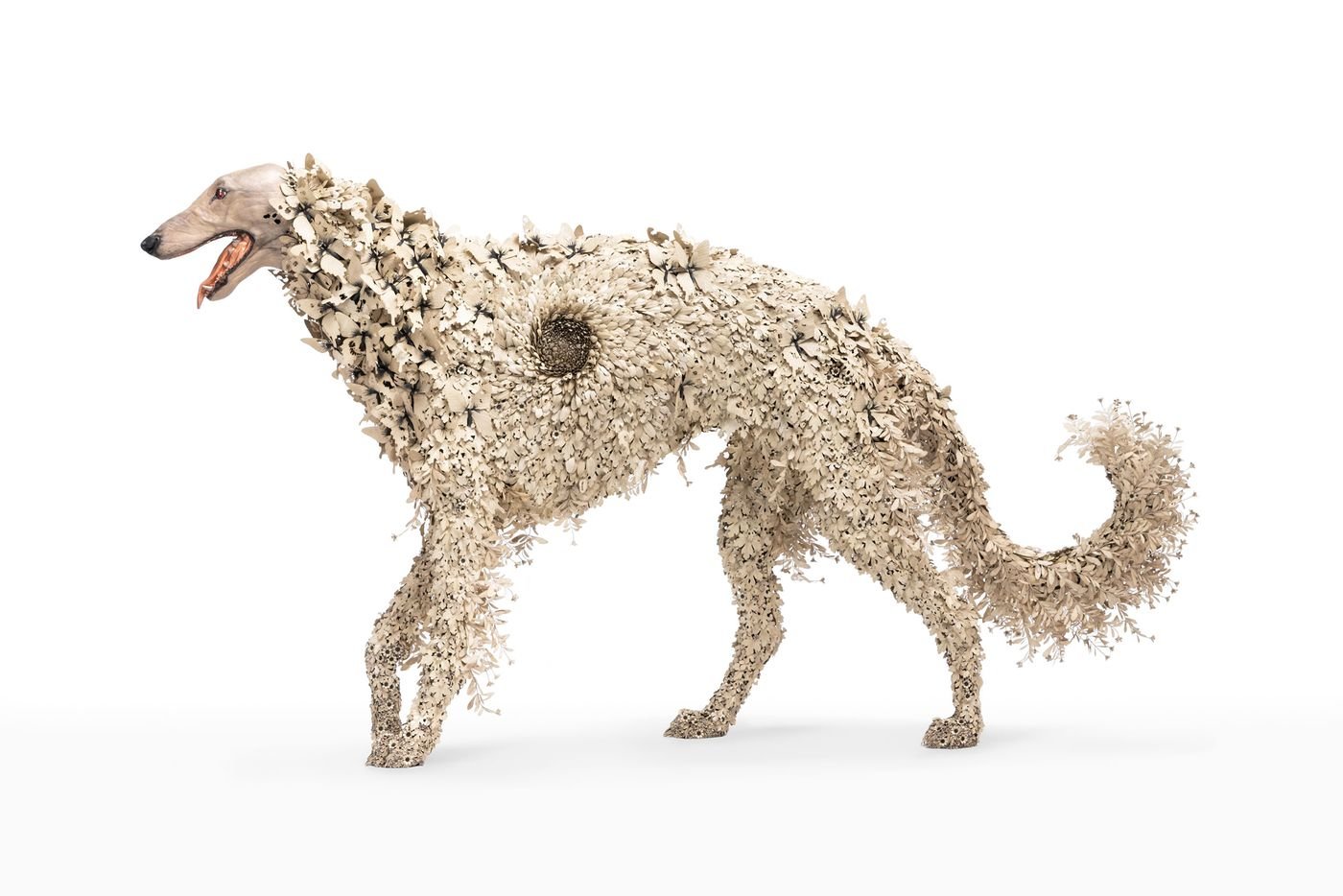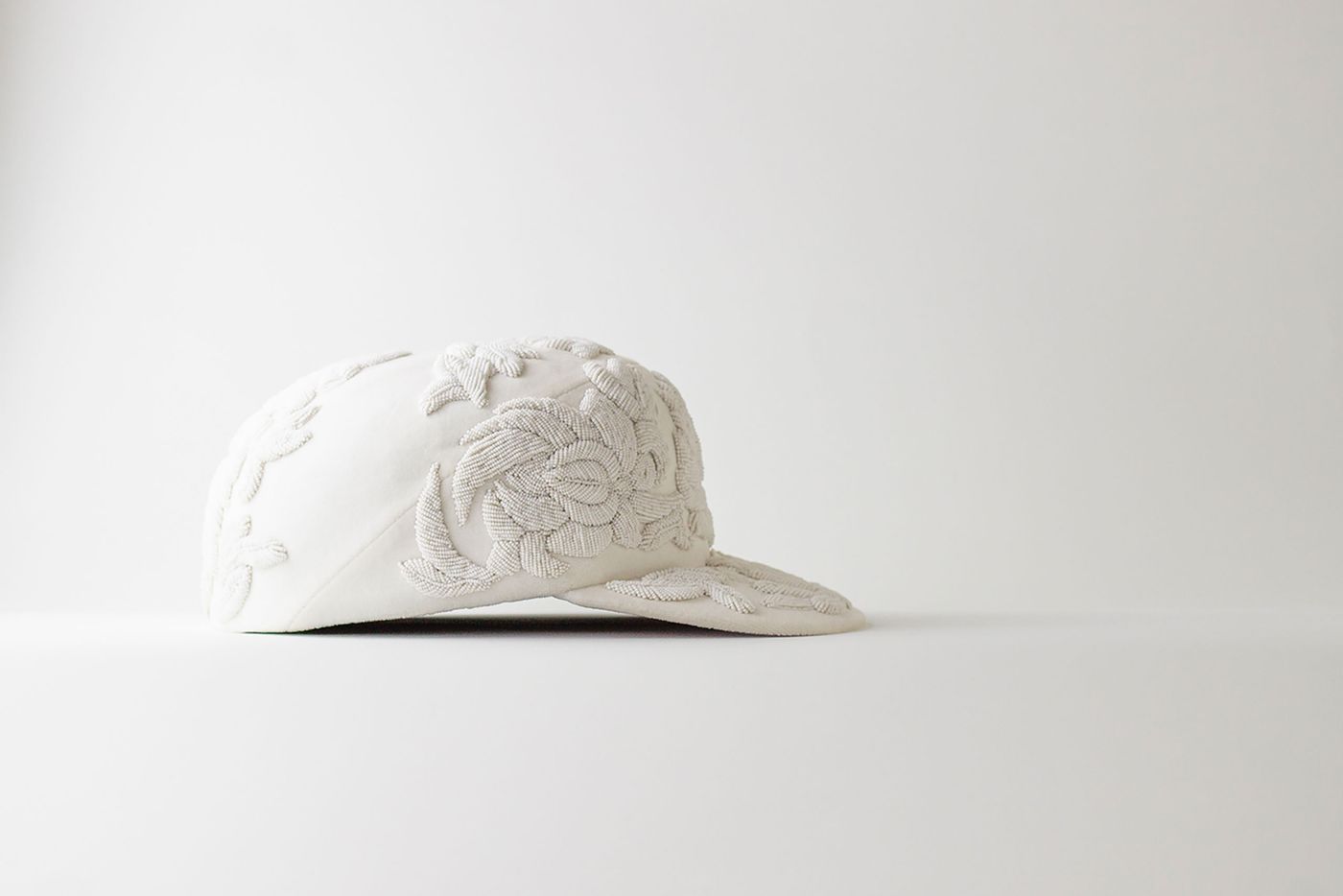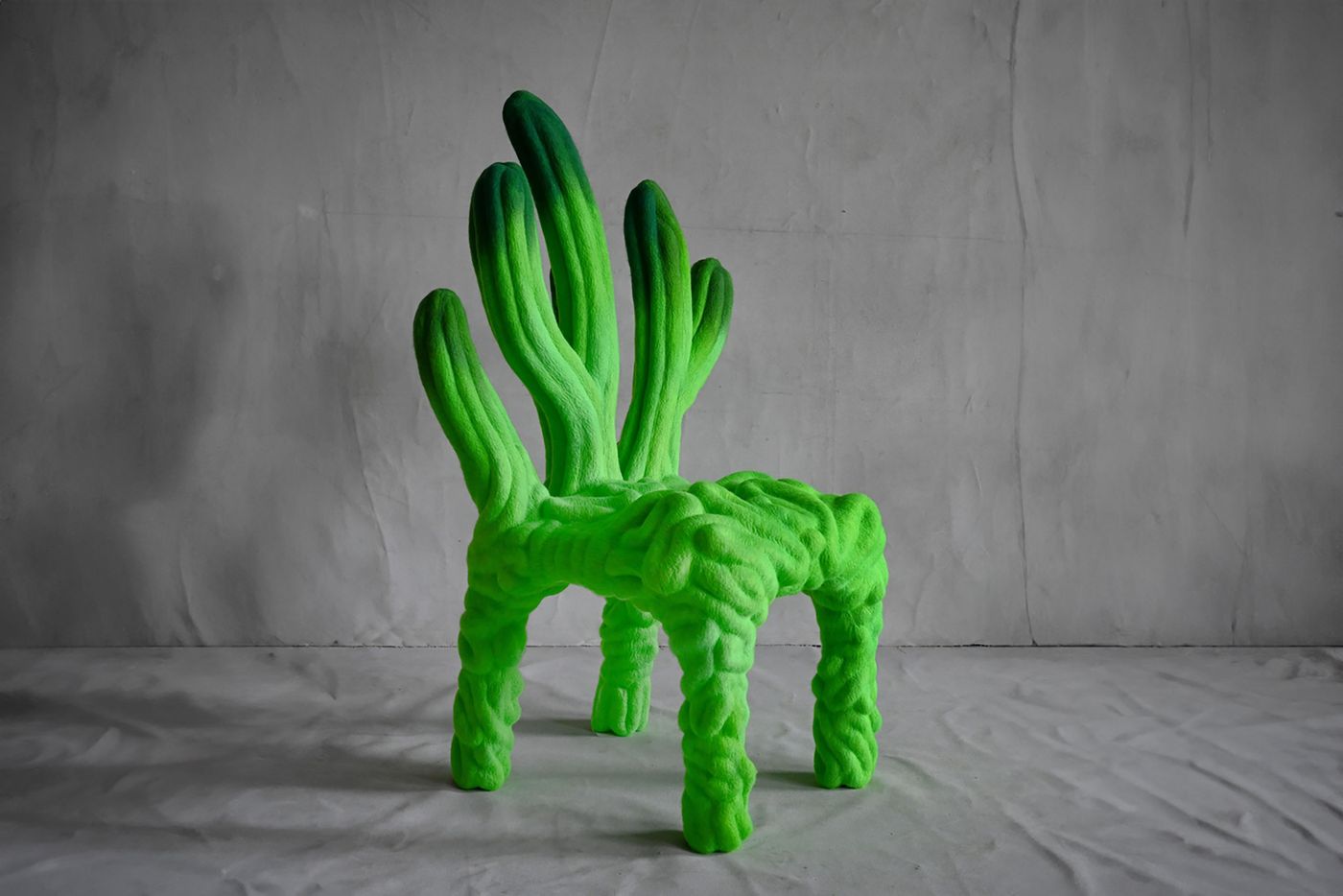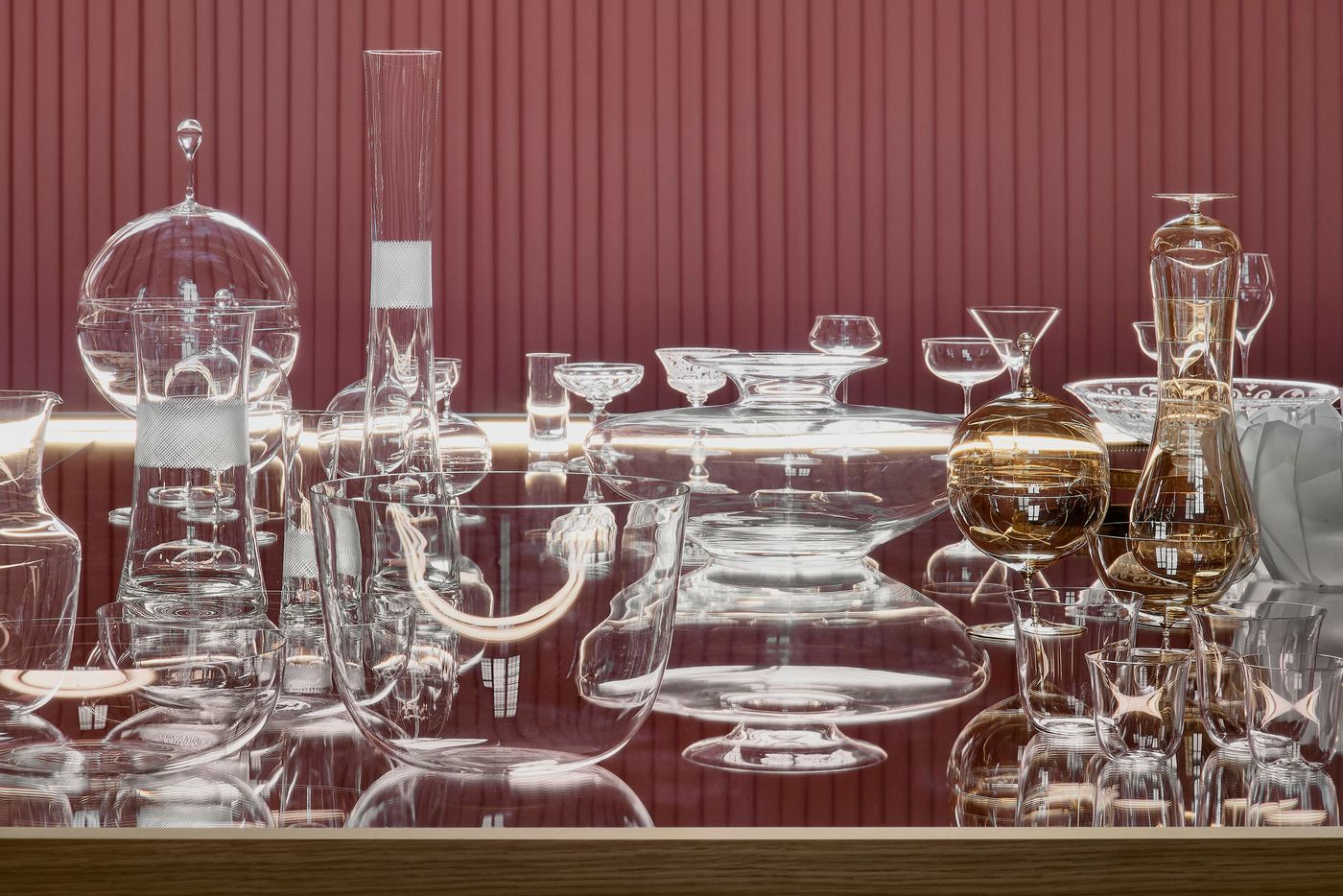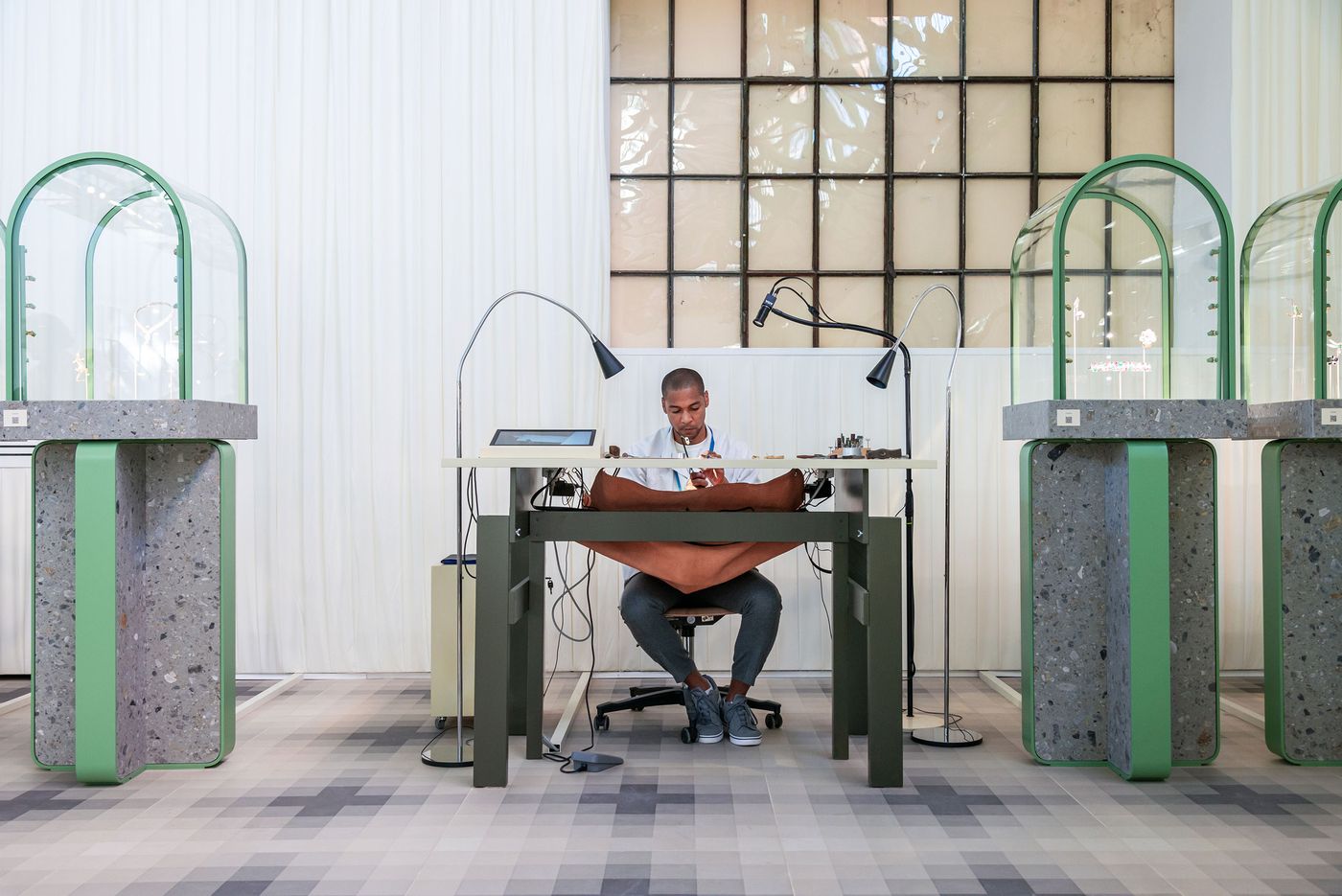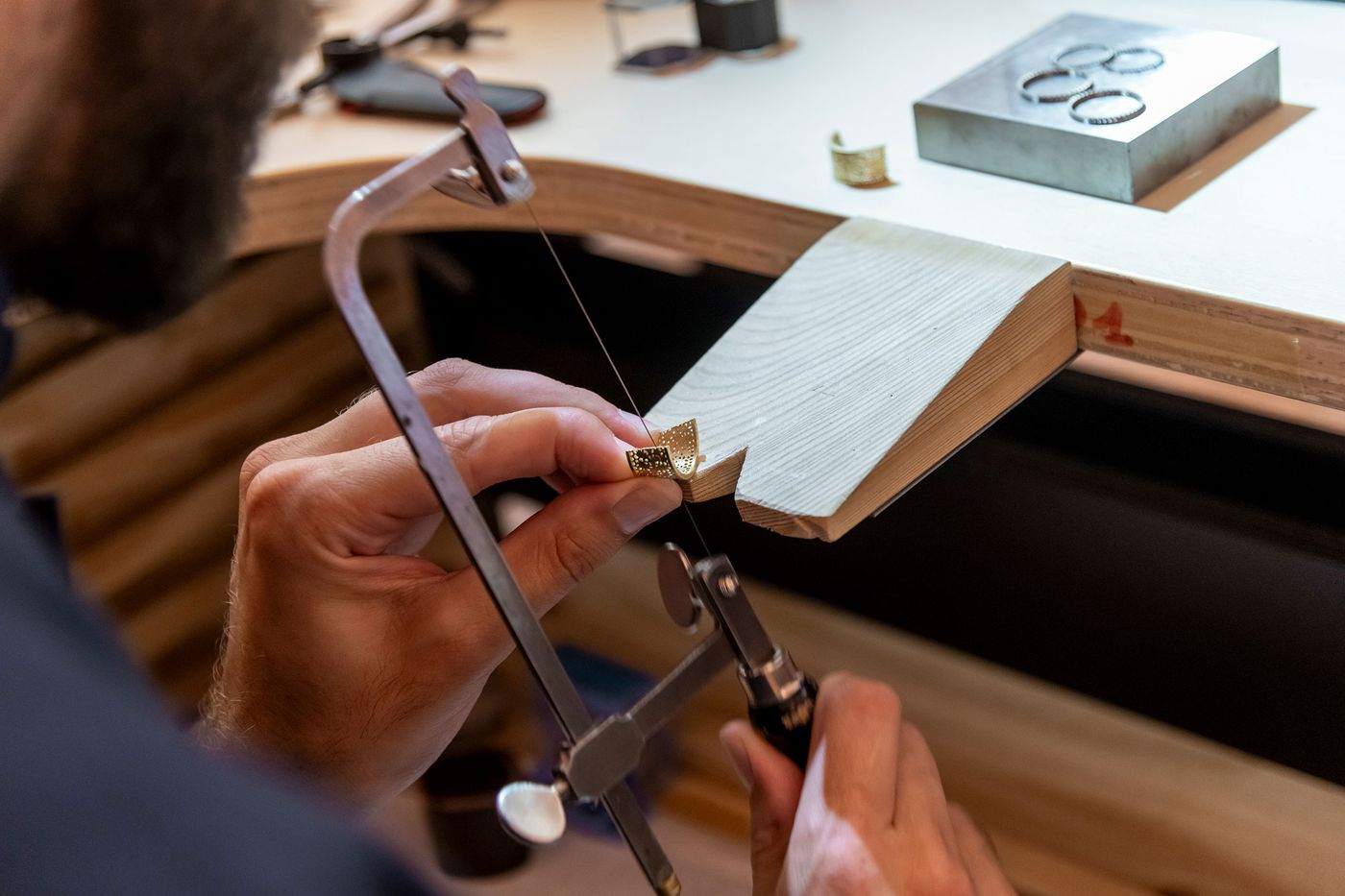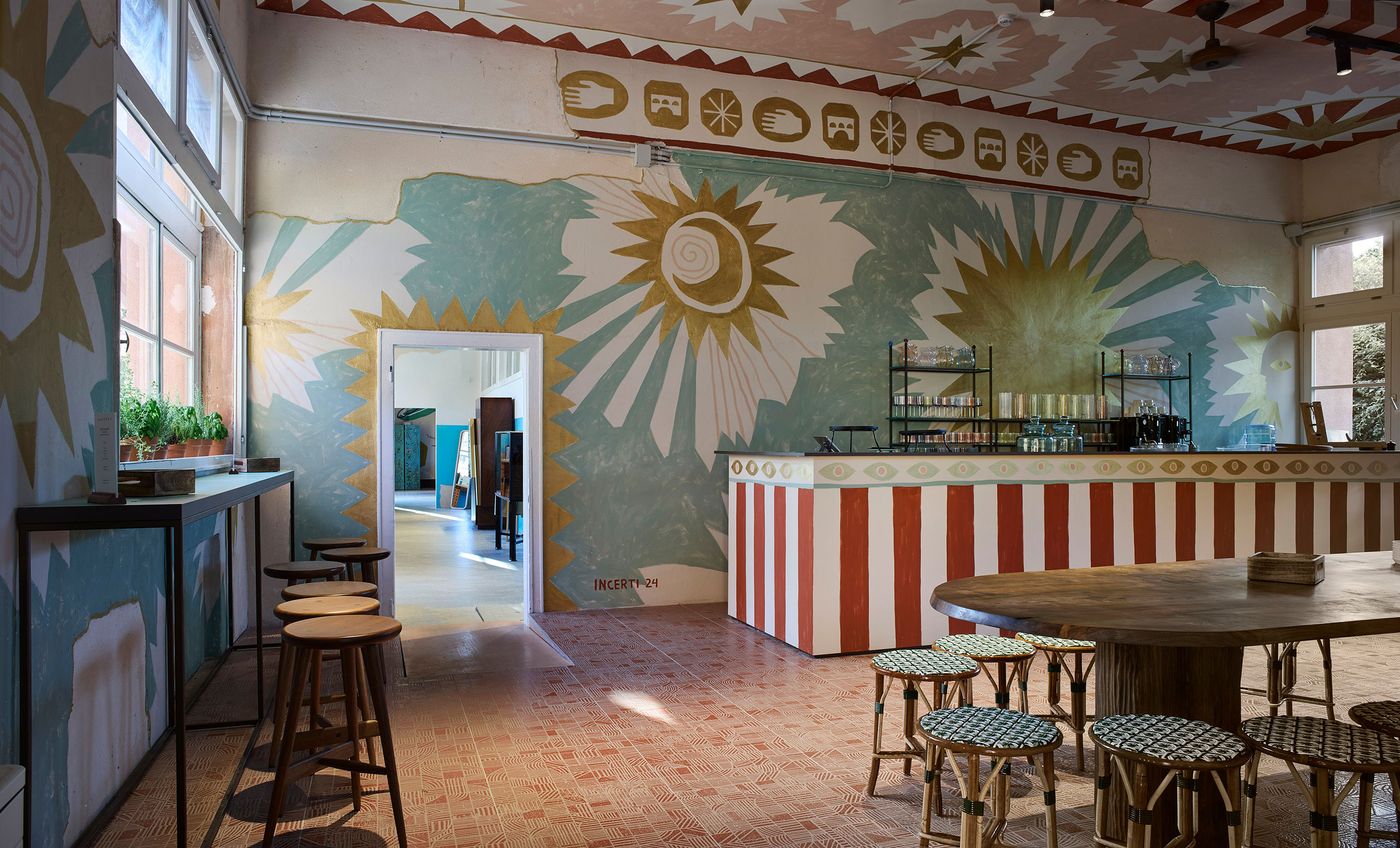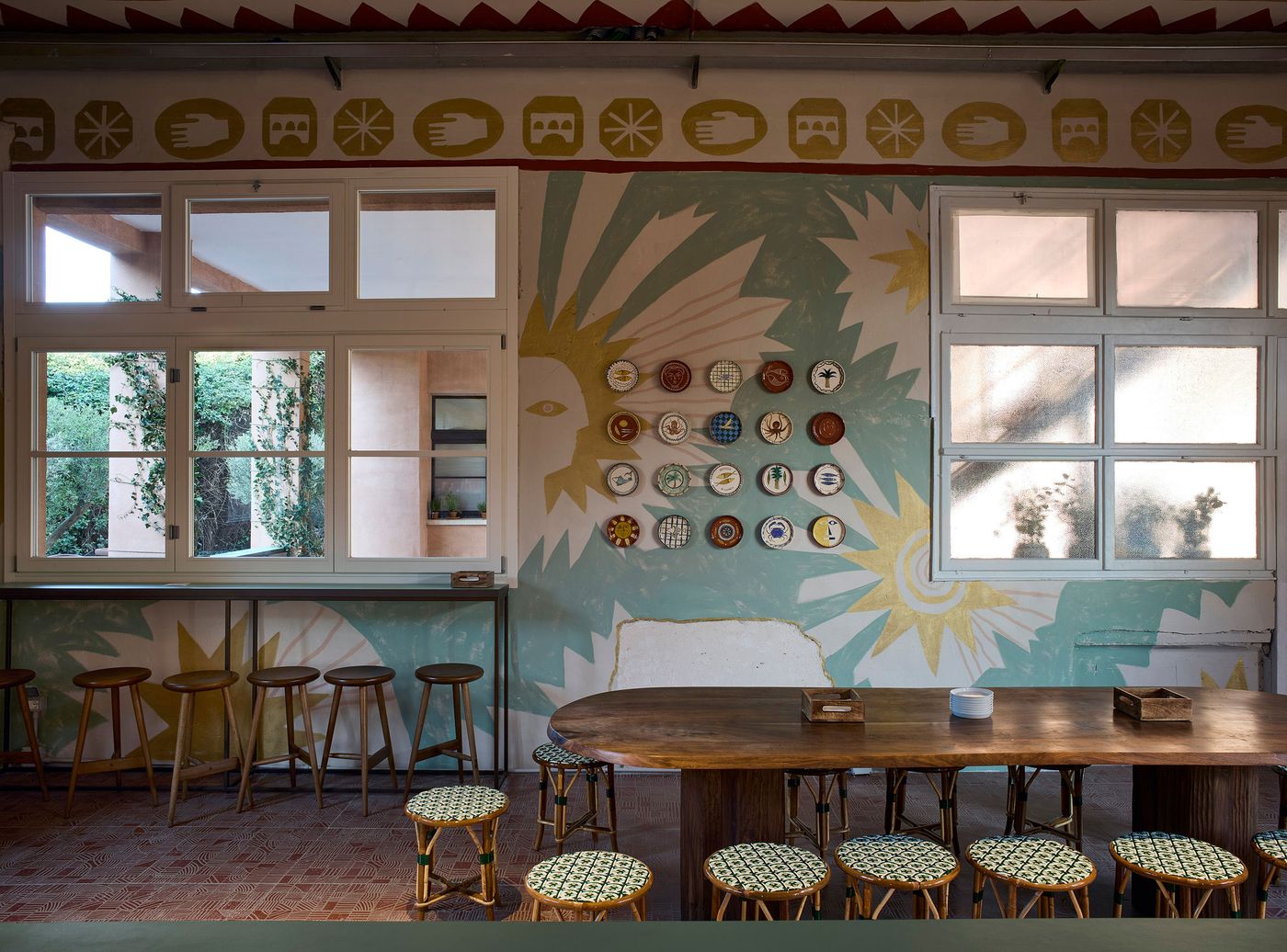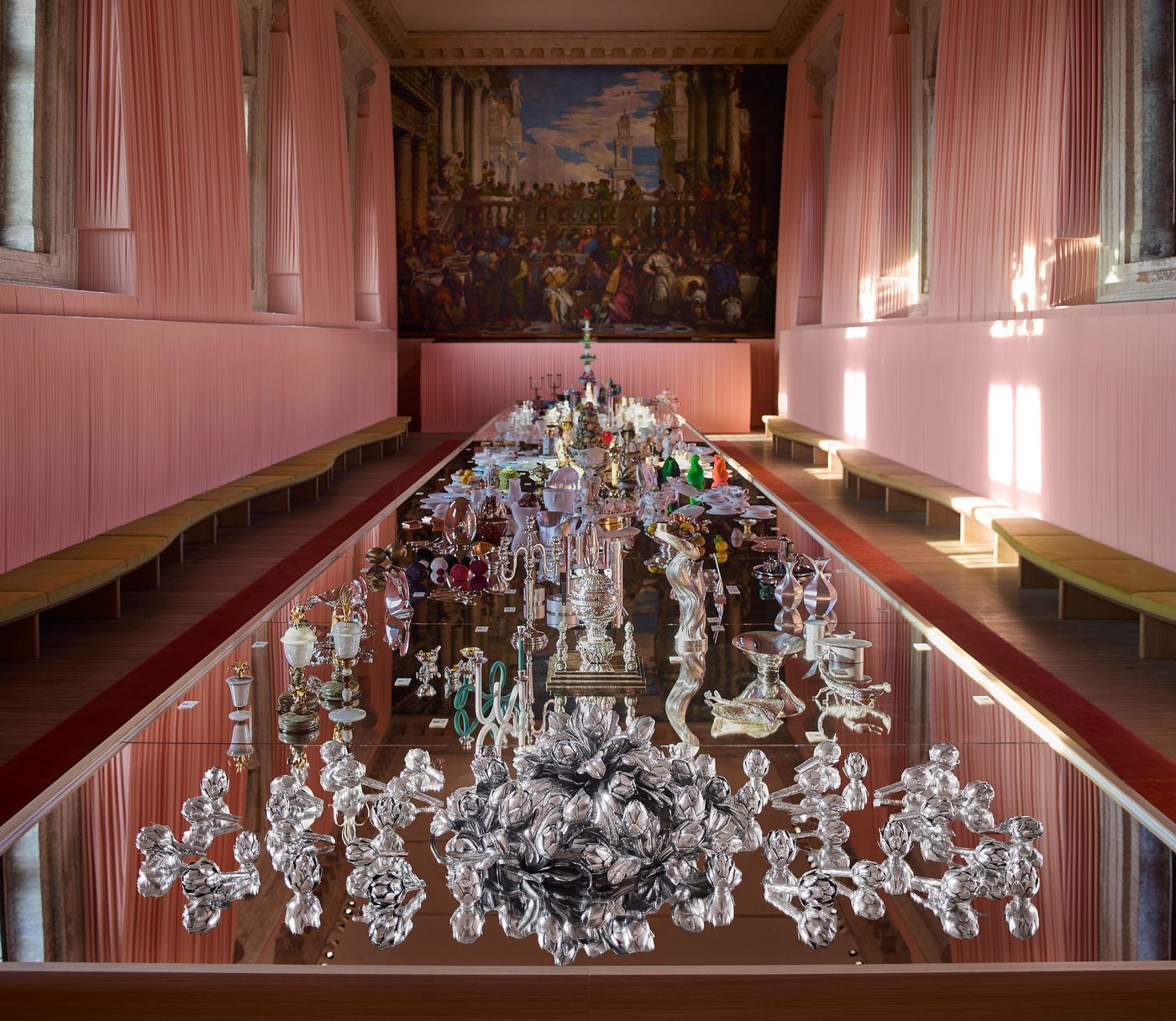
Homo Faber 2024: Luca Guadagnino & Nicolò Rosmarini's Cinematic Journey Through Contemporary Craftsmanship
Words by Yatzer
Location
Venice, Italy
Homo Faber 2024: Luca Guadagnino & Nicolò Rosmarini's Cinematic Journey Through Contemporary Craftsmanship
Words by Yatzer
Venice, Italy
Venice, Italy
Location
Nestled on one of Venice’s most serene, secluded islands, the 16th-century San Giorgio Monastery stands worlds apart from the modernist Palazzo del Cinema on the lively Lido, the main venue of the Venice Film Festival. This year however sees these two seemingly disparate worlds artfully connected through the vision of acclaimed film director Luca Guadagnino whose striking scenography sets the stage for the third edition of Homo Faber, the biennial celebration of contemporary craftsmanship at the San Giorgio Monastery (now the home of the Fondazione Giorgio Cini).
Organized by the Geneva-based Michelangelo Foundation for Creativity & Craftsmanship, the exhibition (running from September 1–30, 2024) unfolds across 11 themed chapters charting “The Journey of Life,” a concept envisioned by the Foundation’s Vice-Chair Hanneli Rupert and evocatively brough to life by Guadagnino, an accomplished interior designer as well as filmmaker, and Milanese architect Nicolò Rosmarini, the project manager of his eponymous interior design studio. From Birth to Afterlife, and through stages such as Childhood, Love and Dreams, visitors embark on journey that spans the full spectrum of the human experience underpinned by a wondrous, atmospheric energy that mirrors the visual richness of Guadagnino’s cinematic style—serendipitously on display across the lagoon with the premiere of his latest film, Queer, during the Venice Film Festival.
Showcasing over 800 handcrafted objects created by around 400 artisans and studios from 75 countries, a significant change from the previous editions that focused on Europe, the exhibition’s curation was certainly no easy task for Alberto Cavalli, Executive Director of the Michelangelo Foundation, with the The Journey of Life theme both guiding and complicating the process. Despite the diversity in concepts, techniques, styles and settings, which range from a 16th century refectory to a 1960s indoor swimming pool, there is a cohesive narrative running through the exhibition thanks to Guadagnino and Rosmarini’s art direction, and particularly a vibrant colour palette coupled with recurring motifs such as mirrors and pleated fabrics—the latter used to wrap up entire rooms as a nod to Venetian-born designer Carlo Scarpa. Striking elements like a pair towering 12-metre papier-mâché cypress trees, a forest of high-tech chandeliers and a sinuous 3D-printed pink ribbon sculpture weaving its way around the columns of one of the cloisters, further underscore the scenographers’ zany theatricality, imbuing the historic spaces with a sense of joviality and wonder.
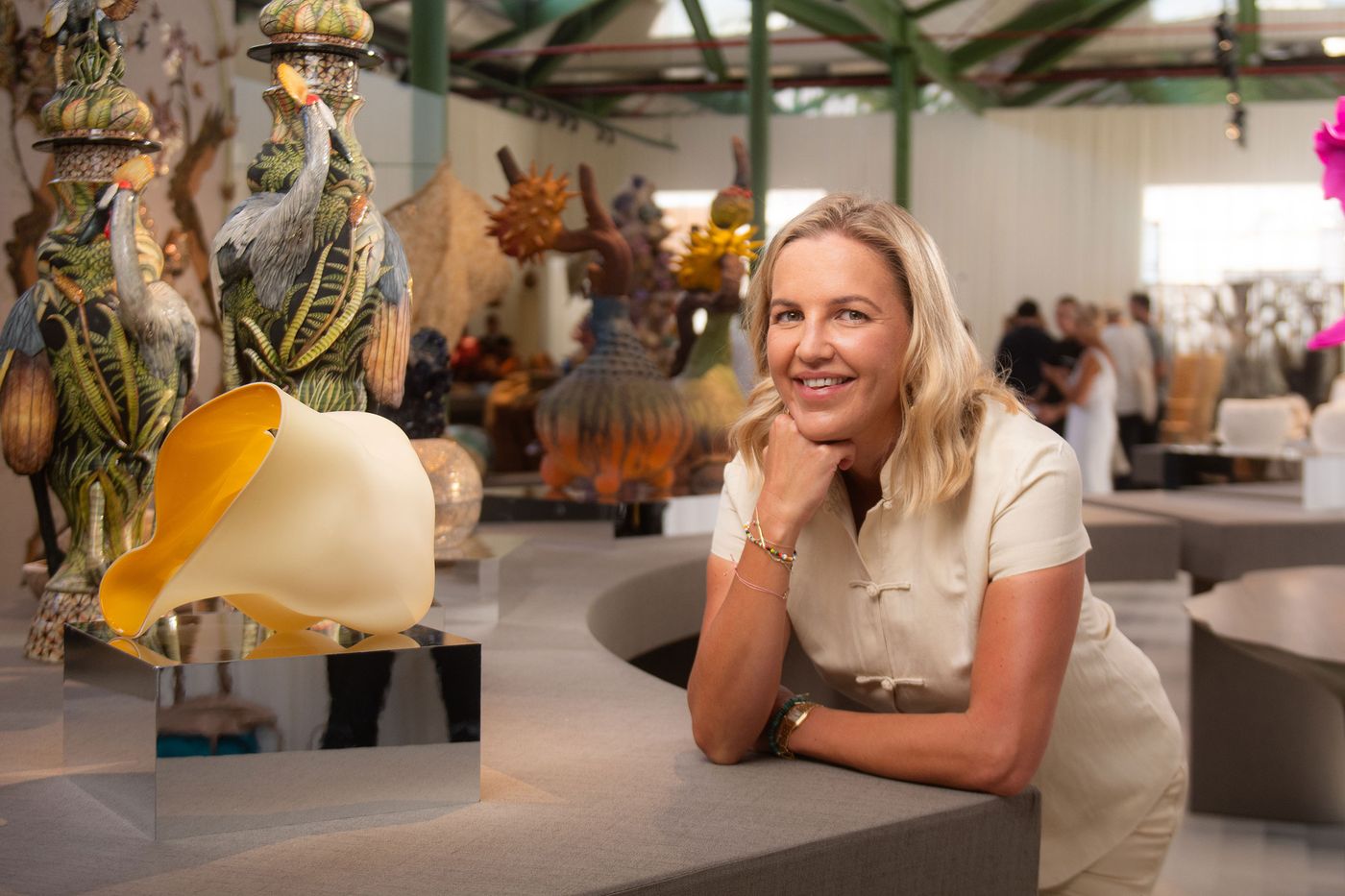
Hanneli Rupert, Vice Chair of the Michelangelo Foundation.
Photography by Simone Padovani. © Michelangelo Foundation.
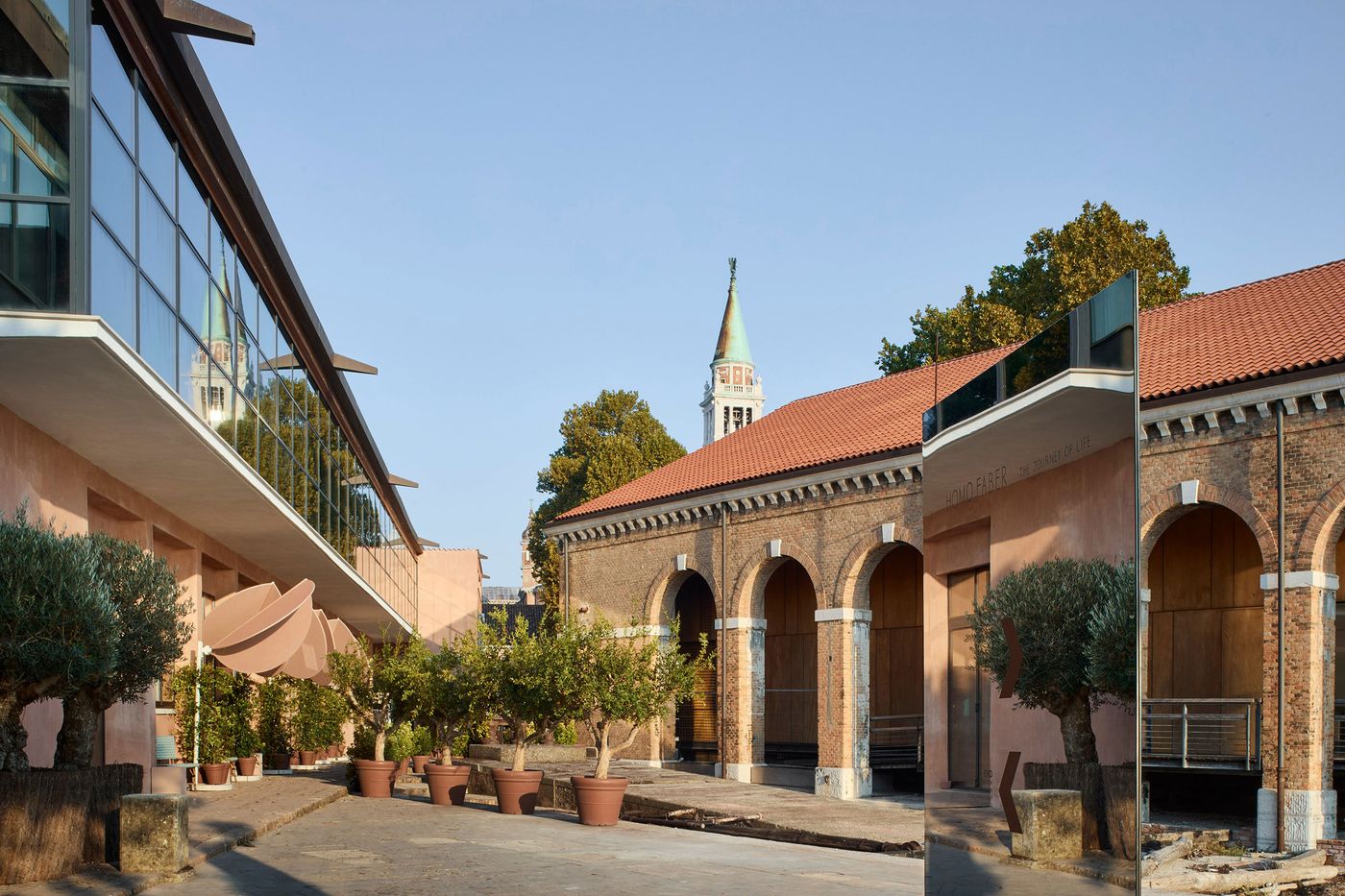
Photography by Alessandra Chemollo.© Michelangelo Foundation.
Almost resembling an enormous umbilical cord, the aforementioned ribbon (the work of Studio Luca Guadagnino) sets off the visitors’ journey in the Birth section in one of the monastery’s cloisters. Lining the cloister’s walls are sixty colourful tapestries, a collaborative embroidery project developed especially for Homo Faber by British artist and illustrator Nigel Peake. Inspired by the 15th-century “Game of the Goose”, one of the first commercially manufactured board games, Peake created a series of designs which were then sent to artisans around the world to interpret in their own unique way. The result is a showcase of diverse techniques and cultural traditions.For instance, Nodir Rasulov used 30 different gold embroidery techniques from Uzbekistan, artisans at de Gournay’s Kolkata studio drew on West Bengal’s rich embroidery traditions using a blend of silk thread work, beading, and goldwork on appliqué while the female artisans of the South African Mapula Embroidery Project showcase the artistic skills they perfected as part of their community art project.
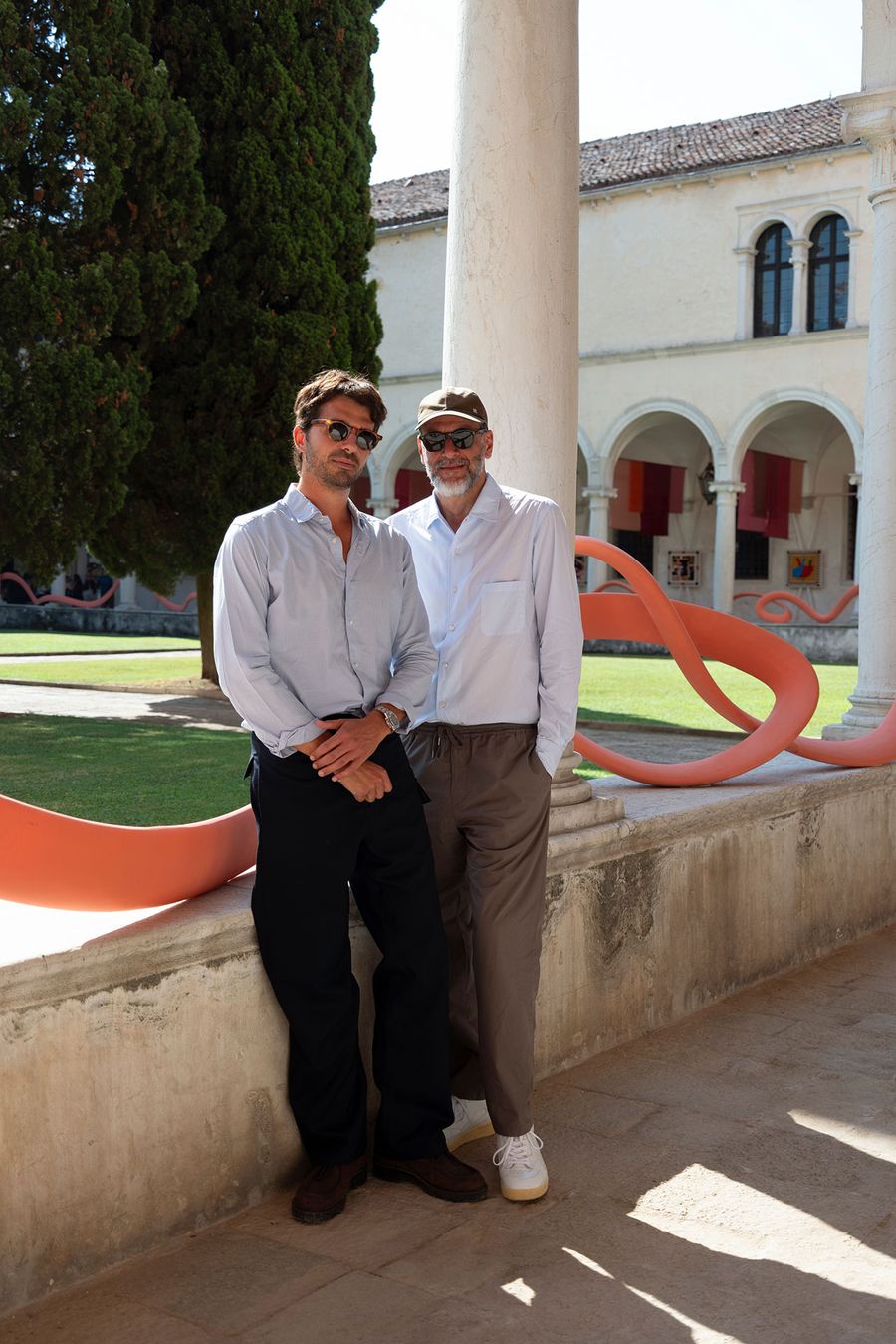
Luca Guadagnino (right) & Nicolò Rosmarini.
Photography by Giulio Ghirardi.© Michelangelo Foundation.
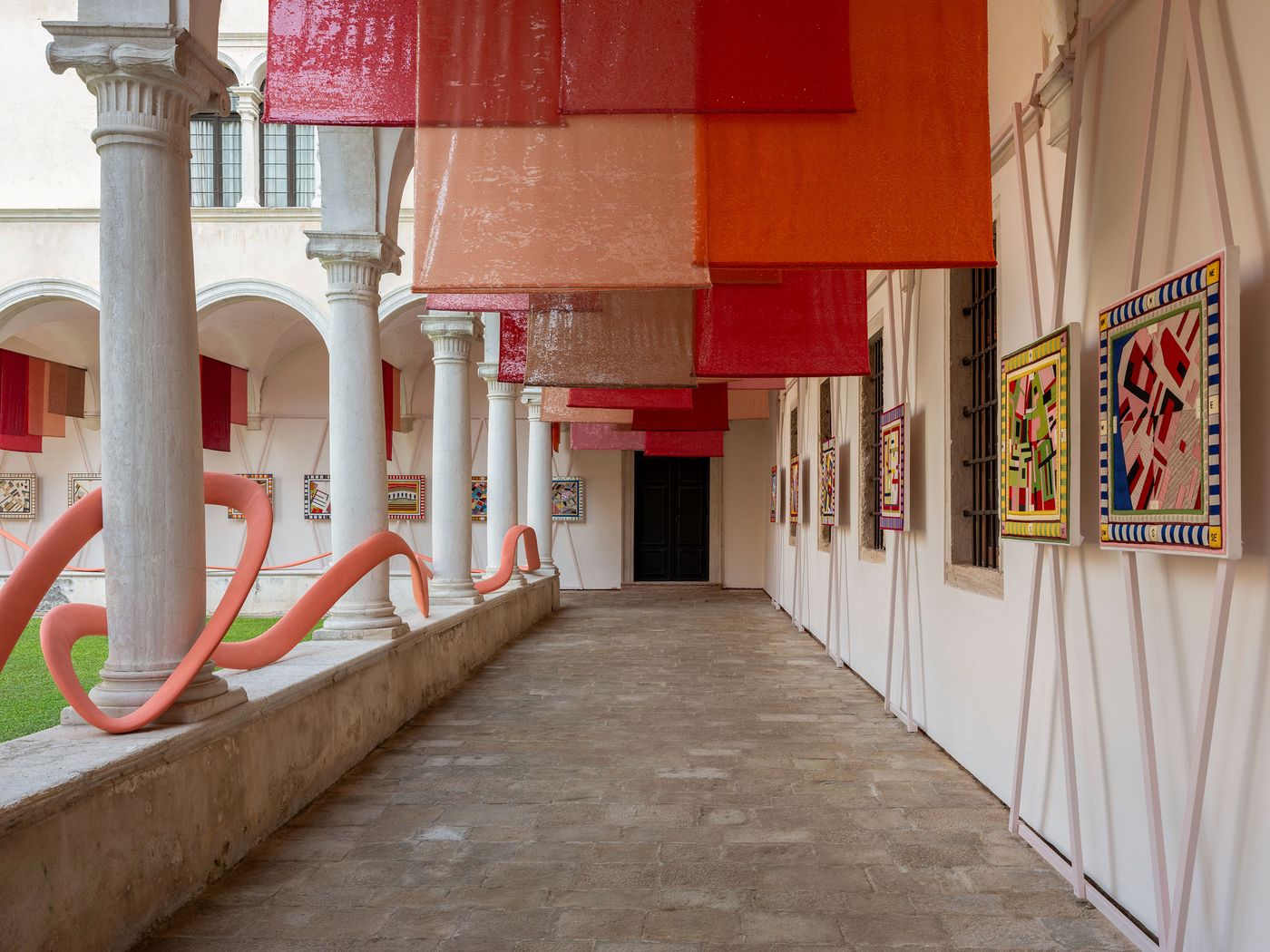
Birth.Photography by Giulio Ghirardi.© Michelangelo Foundation.
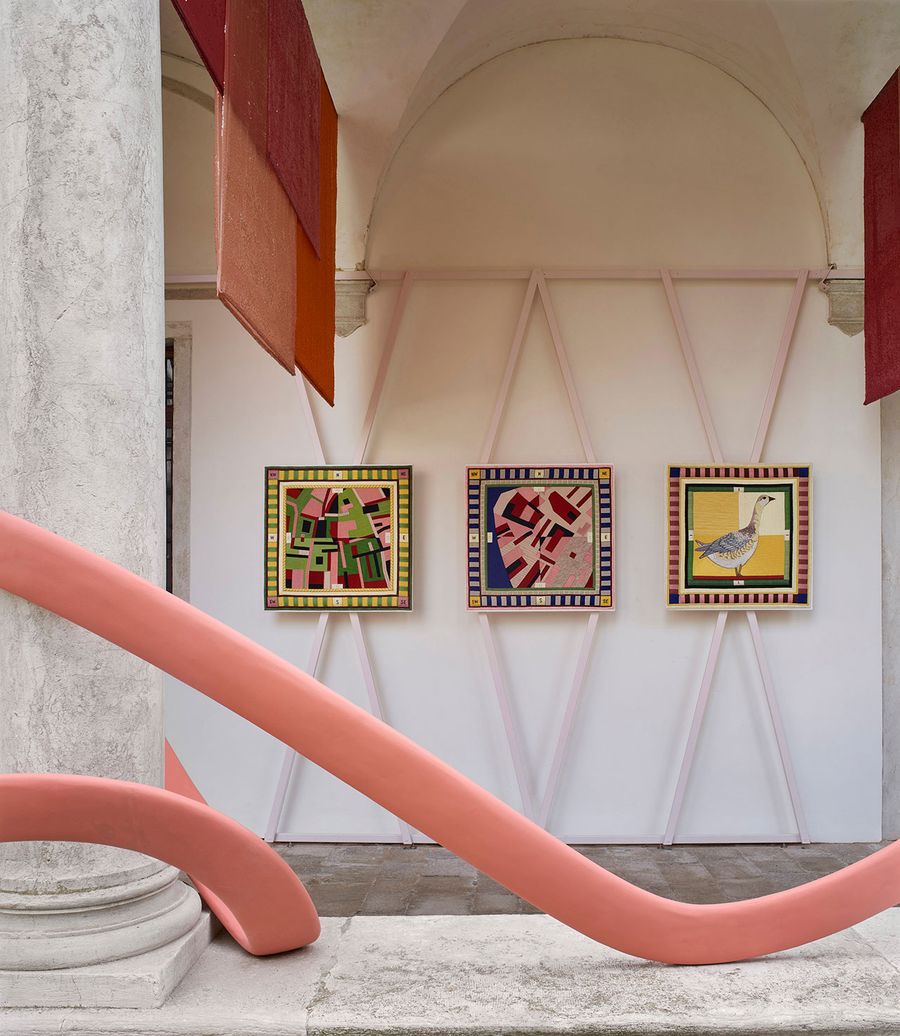
Birth."Game of the Goose I, II, III" (2024) tapestries by de Gournay, design by Nigel Peake.Photography by Alessandra Chemollo.© Michelangelo Foundation.

Birth."Game of the Goose I, II, III" (2024) tapestries by de Gournay, design by Nigel Peake.Photography by Alessandra Chemollo.© Michelangelo Foundation.
Covered in floor-to-ceiling blue drapes, the Childhood section exudes a sense of childlike exuberance with an array of colourful toy-like objects vying for your attention. Giovanni Francesco Simeti and Giovanni Bonotto’s immense tapestry sets the tone – made on a jumbo jacquard loom, the 4.2 by 3.4-metres piece is inspired by the portrayal of games in contemporary media.
Designs that caught our eye in this room include two whimsical chairs, one by American designer Liam Lee, the other by South Korean designer Seungjin Yang, both whimsical manifestations of colour and form. Crafted from needle-felted, acid-dyed merino wool, Lee’s biomorphic chair stands out with its neon-green hue, while Yang’s balloon-shaped chair, which he made by applying epoxy resin to actual balloons, is hard to miss thanks to its glossy yellow texture.Swedish audio-visual artist Love Hultén’s handcrafted wooden synthesizer also made an impression with its 25 sets of plastic teeth, each set representing a unique note, as did Japanese artist Taiichiro Yoshida’s dog sculpture which is made from hundreds of metallic butterflies and flowers, each handcrafted using traditional metalworking techniques, and finally Giuseppe Savoca's masterfully embroidered baseball cap (part of the Renaissance MMXX Collection).
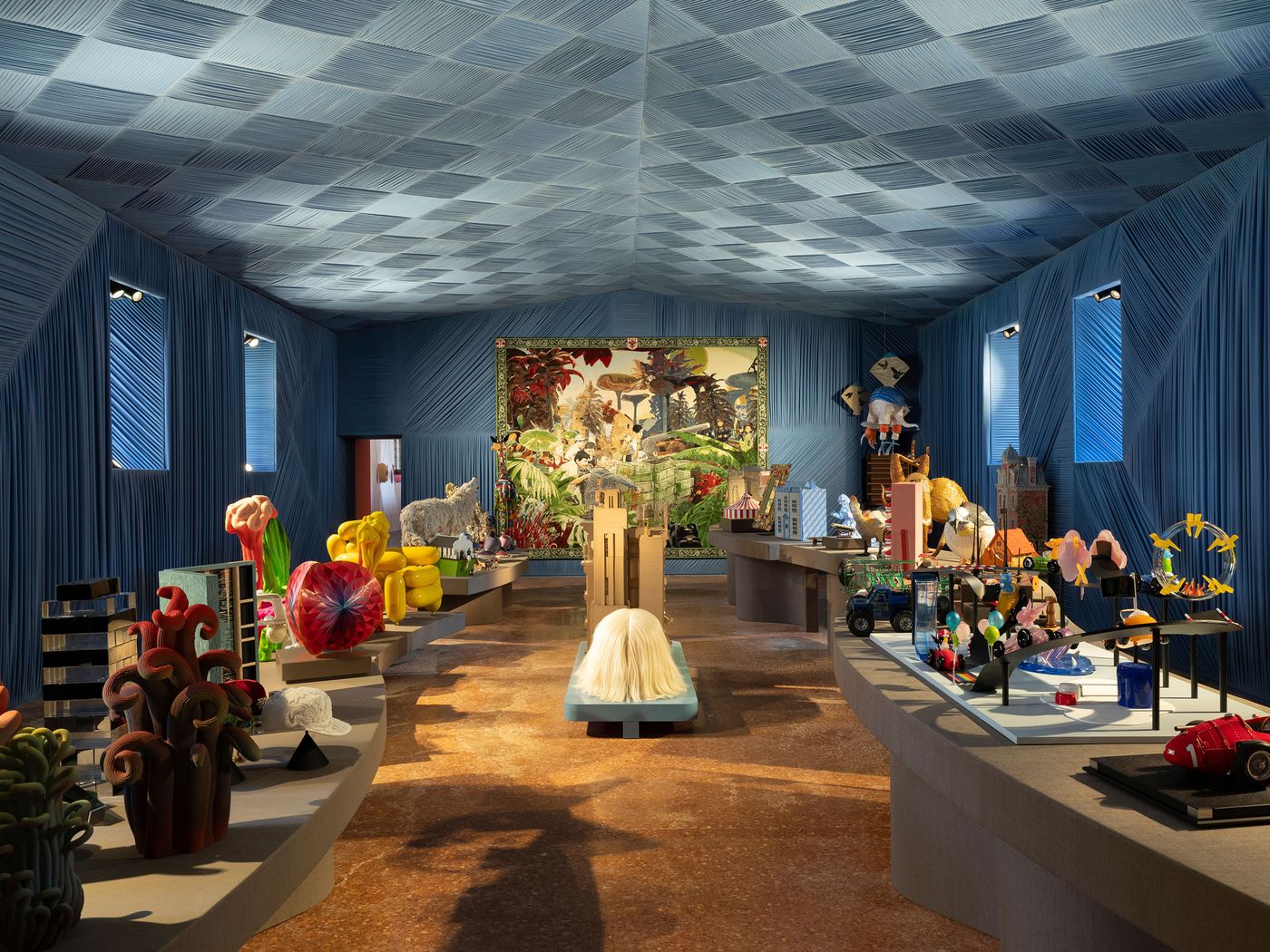
Childhood. Photography by Giulio Ghirardi. © Michelangelo Foundation.
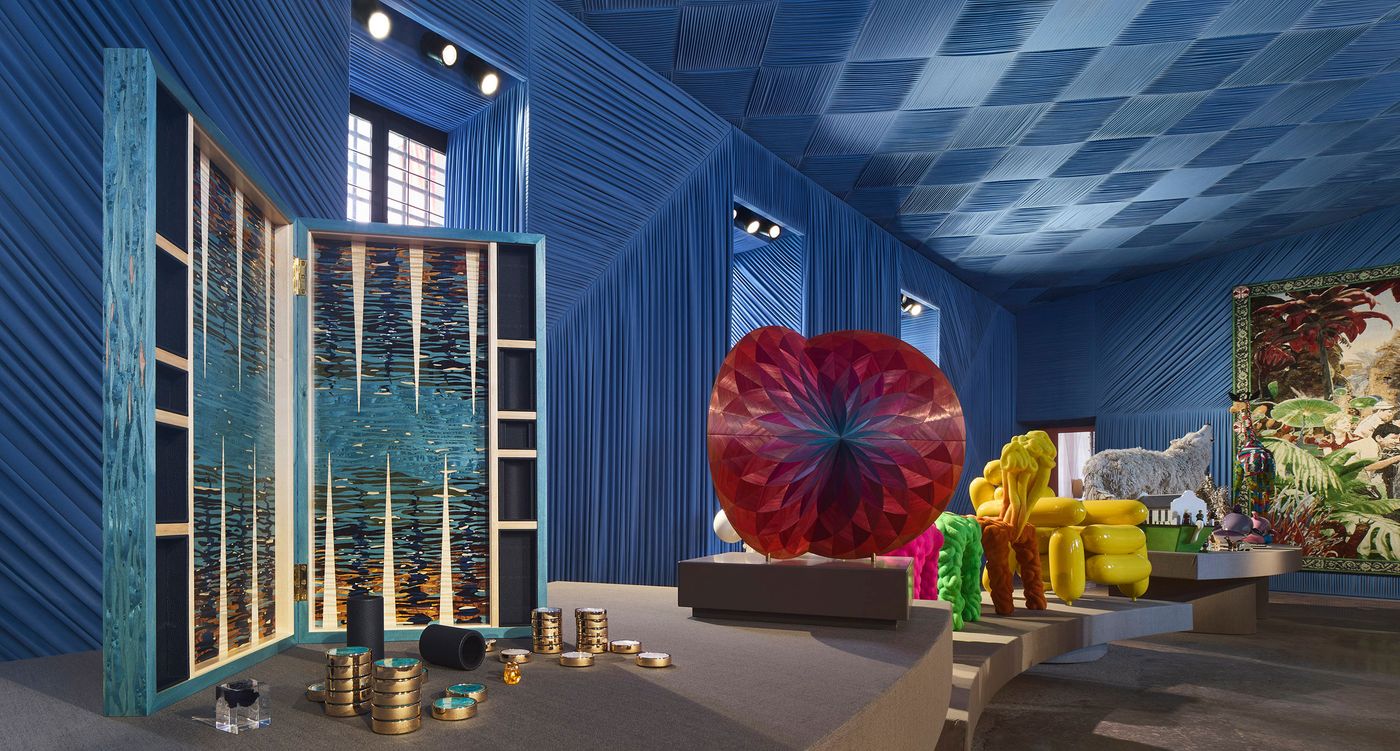
Childhood.Left: "Bespoke backgammon set" (2024) by Alexandra Llewellyn; Centre: "Florescence, Red Pod" (2023) by Adam Goodrum and Arthur Seigneur; Right: "C’Era una Volta una Guerra (Gianni Rodari)" (2024) by Giovanni Francesco Simeti and Giovanni Bonotto.Photography by Alessandra Chemollo.© Michelangelo Foundation.

“Tu Fai 'Pum' e Ridi (Bertold Brecht)” (2024) by Giovanni Francesco Simeti and Giovanni Bonotto.
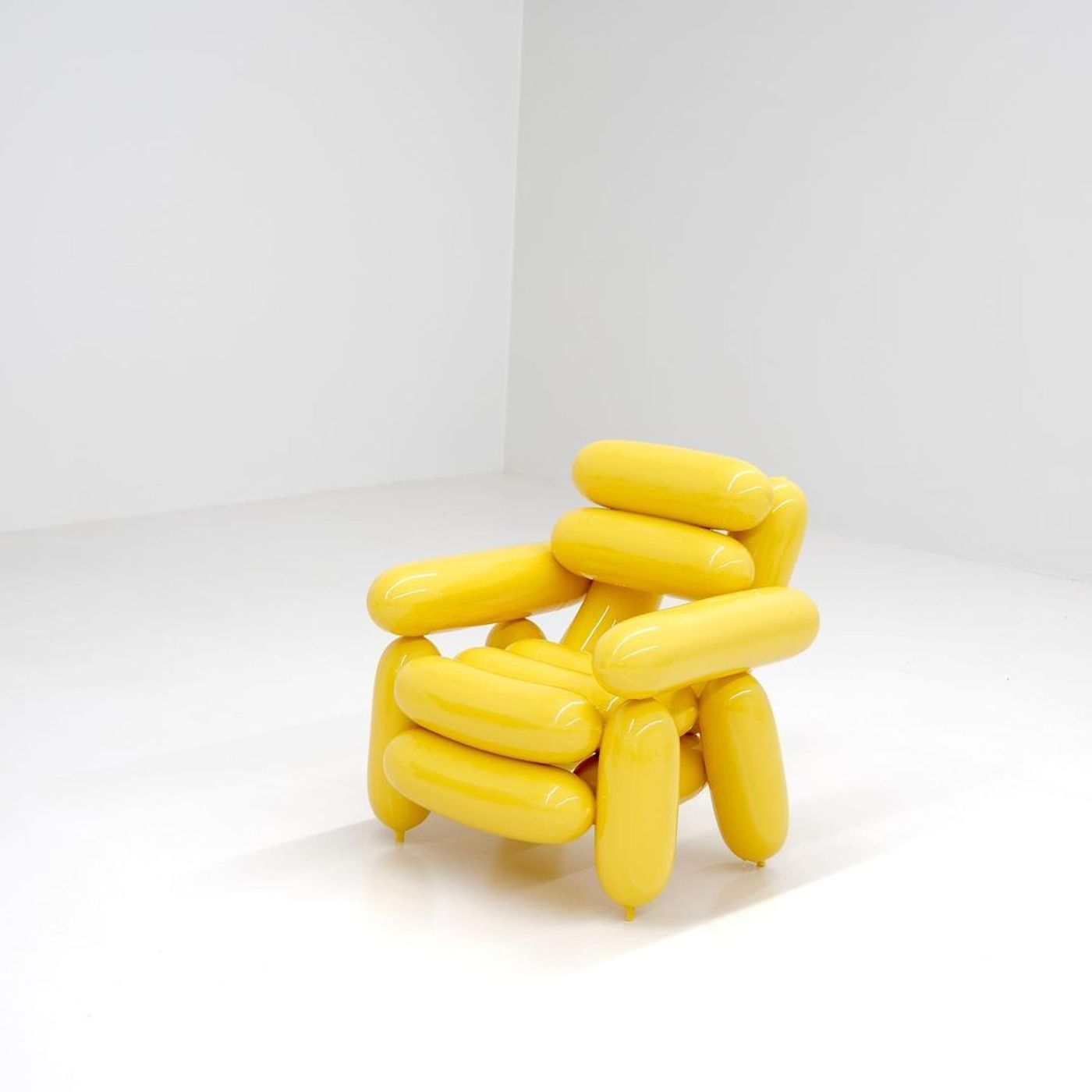
"Blowing Lounge 1" (2024) by Seungjin Yang.
In the powder pink-draped Celebration section, which takes over the monastery’s most impressive space, the Andrea Palladio-designed refectory, Guadagnino and Rosmarini have conjured a celebratory feast of high craftsmanship by introducing a mirrored banqueting table running the length of the room, laden with an abundance of unique tableware and decorative objects. From masterfully crafted silverware such as Nan Nan Liu's tree-like candlestick, Helena Schepens’ filigree decorative bowl, Buccellati’s artichoke-filled centrepiece and Philipp Gröninger’s modern version of a traditional Japanese chadô teapot (complete with a magnetic lid), to hand-painted ceramic plates by Milan-based Laboratorio Paravicini, colourful hand-blown glasses by Canadian father and daughter team Peter & Iris Gudrunas, and iconic drinking sets by legendary Viennese glassware company Lobmeyr, the kaleidoscopic installation celebrates the art of hosting in its most magnificent form.
Also spotted, UK-based embroiderer Youmeng Liu’s textile version of an English breakfast, which was created using her newly developed 3D punch needle embroidery technique, and a pair of ceramic candle holders from South African brand Ardmore playfully adorn with cheetahs, velvet monkeys and aloe fronds. The striking setup is enhanced by a wool carpet custom-made by Jaipur Rugs based on the watercolour painting that Guadagnino and Rosmarini designed for the Homo Faber 2024 logo. Swathed in abstract splashes of block colours, the carpet is a playful counterpoint to Veronese’s monumental painting “Wedding at Cana”—sadly a reproduction, the original having been plundered by Napoleon’s army and now hanging in the Louvre.
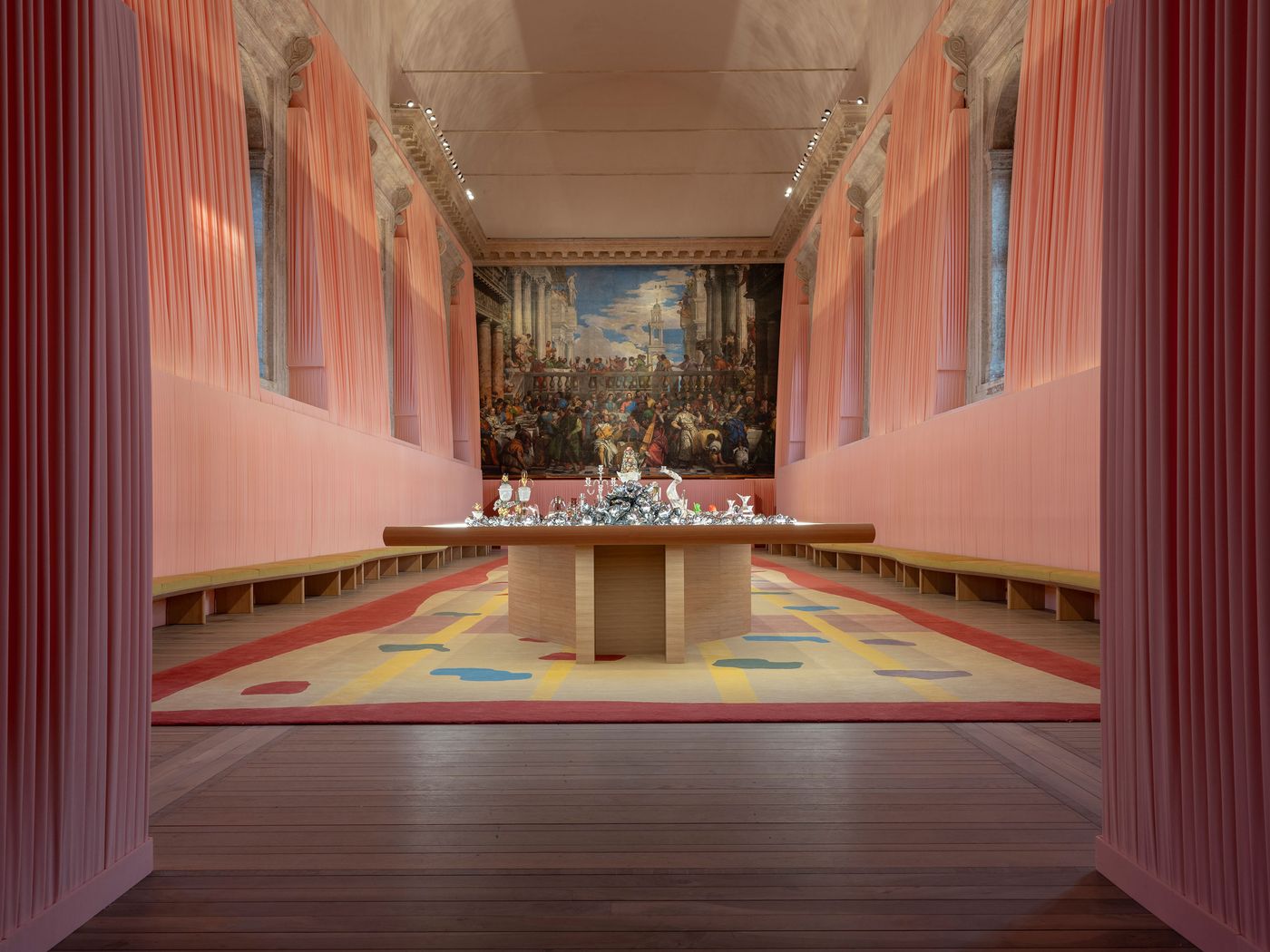
Celebration. Photography by Giulio Ghirardi. © Michelangelo Foundation.
In the powder pink-draped Celebration section, which takes over the monastery’s most impressive space, the Andrea Palladio-designed refectory, Guadagnino and Rosmarini have conjured a celebratory feast of high craftsmanship by introducing a mirrored banqueting table running the length of the room, laden with an abundance of unique tableware and decorative objects. From masterfully crafted silverware such as Nan Nan Liu's tree-like candlestick, Helena Schepens’ filigree decorative bowl, Buccellati’s artichoke-filled centrepiece and Philipp Gröninger’s modern version of a traditional Japanese chadô teapot (complete with a magnetic lid), to hand-painted ceramic plates by Milan-based Laboratorio Paravicini, colourful hand-blown glasses by Canadian father and daughter team Peter & Iris Gudrunas, and iconic drinking sets by legendary Viennese glassware company Lobmeyr, the kaleidoscopic installation celebrates the art of hosting in its most magnificent form.
Also spotted, UK-based embroiderer Youmeng Liu’s textile version of an English breakfast, which was created using her newly developed 3D punch needle embroidery technique, and a pair of ceramic candle holders from South African brand Ardmore playfully adorn with cheetahs, velvet monkeys and aloe fronds. The striking setup is enhanced by a wool carpet custom-made by Jaipur Rugs based on the watercolour painting that Guadagnino and Rosmarini designed for the Homo Faber 2024 logo. Swathed in abstract splashes of block colours, the carpet is a playful counterpoint to Veronese’s monumental painting “Wedding at Cana”—sadly a reproduction, the original having been plundered by Napoleon’s army and now hanging in the Louvre.

Celebration. Photography by Giulio Ghirardi. © Michelangelo Foundation.
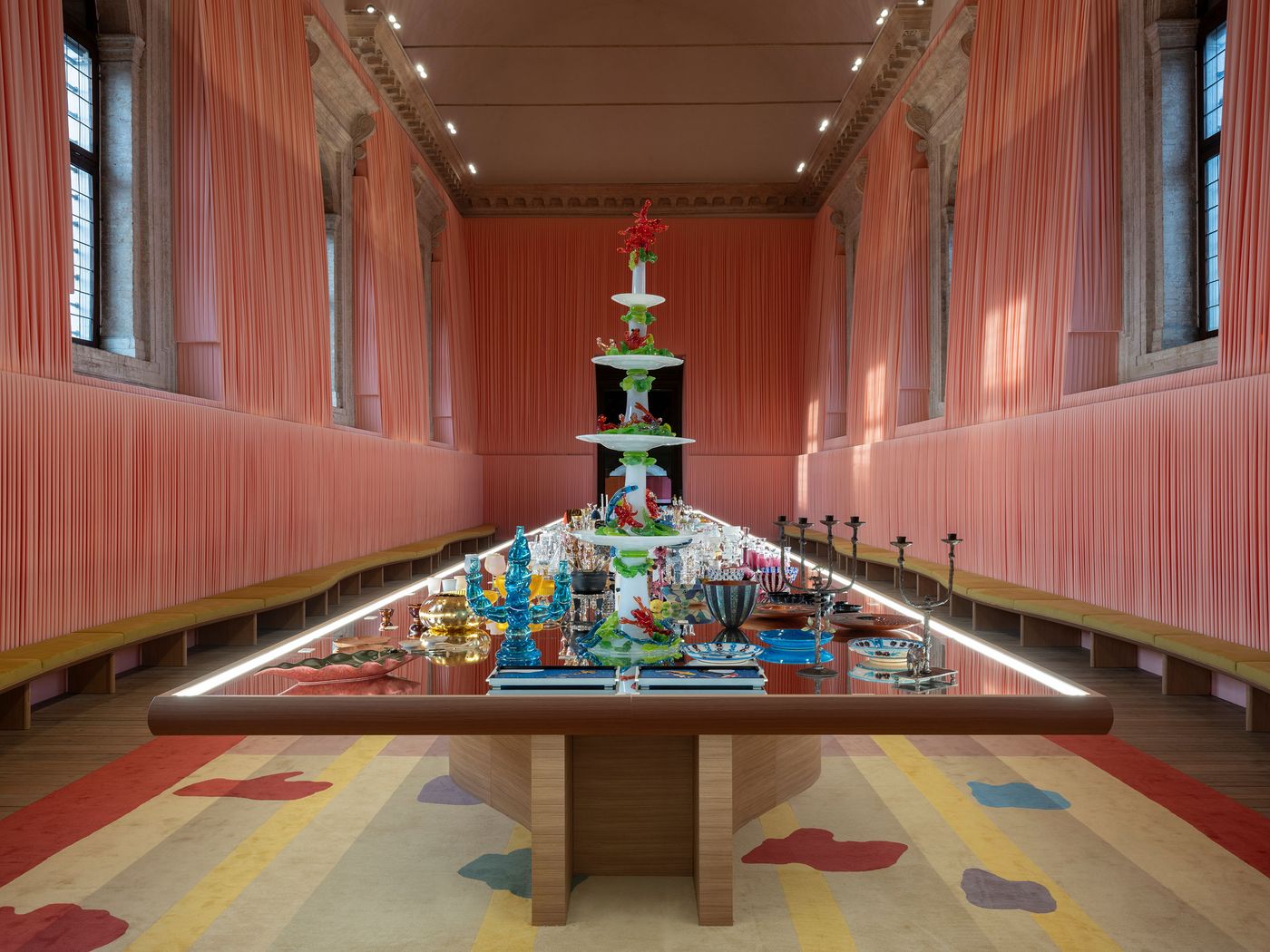
Celebration.
Photography by Giulio Ghirardi. © Michelangelo Foundation.
Focusing on the value of inherited knowledge, the Inheritance section showcases work by family-run brands where craft skills and traditions are passed down from generation to generation such as Italian jewellery maker Villa Milano and Greek soap manufacturer Patounis, the former presenting a selection of cufflinks crafted from multiple stones and the latter a box of olive soaps that were handmade 20 years ago.Love unfolds in two interconnected rooms, one for Courtship and one for Union. In the former, an array of vitrines displays 20 ‘bouquets of flowers’ made from a wide range of materials, from precious stones like yellow gold, emeralds and diamonds (Van Cleef & Arpel’s “Daisy clip”), to porcelain (Anna Volkova's “Tulip Symphony”) and paper (Studio Marianne Guély’s “Eternal Bouquet” and Signe Elisabeth Scharling’s “Blackberry Branch”). Presented in an otherwise stripped-down room, the installation recalls the enchanted rose in the glass jar in Beaty and the Beast, a symbol of true love.
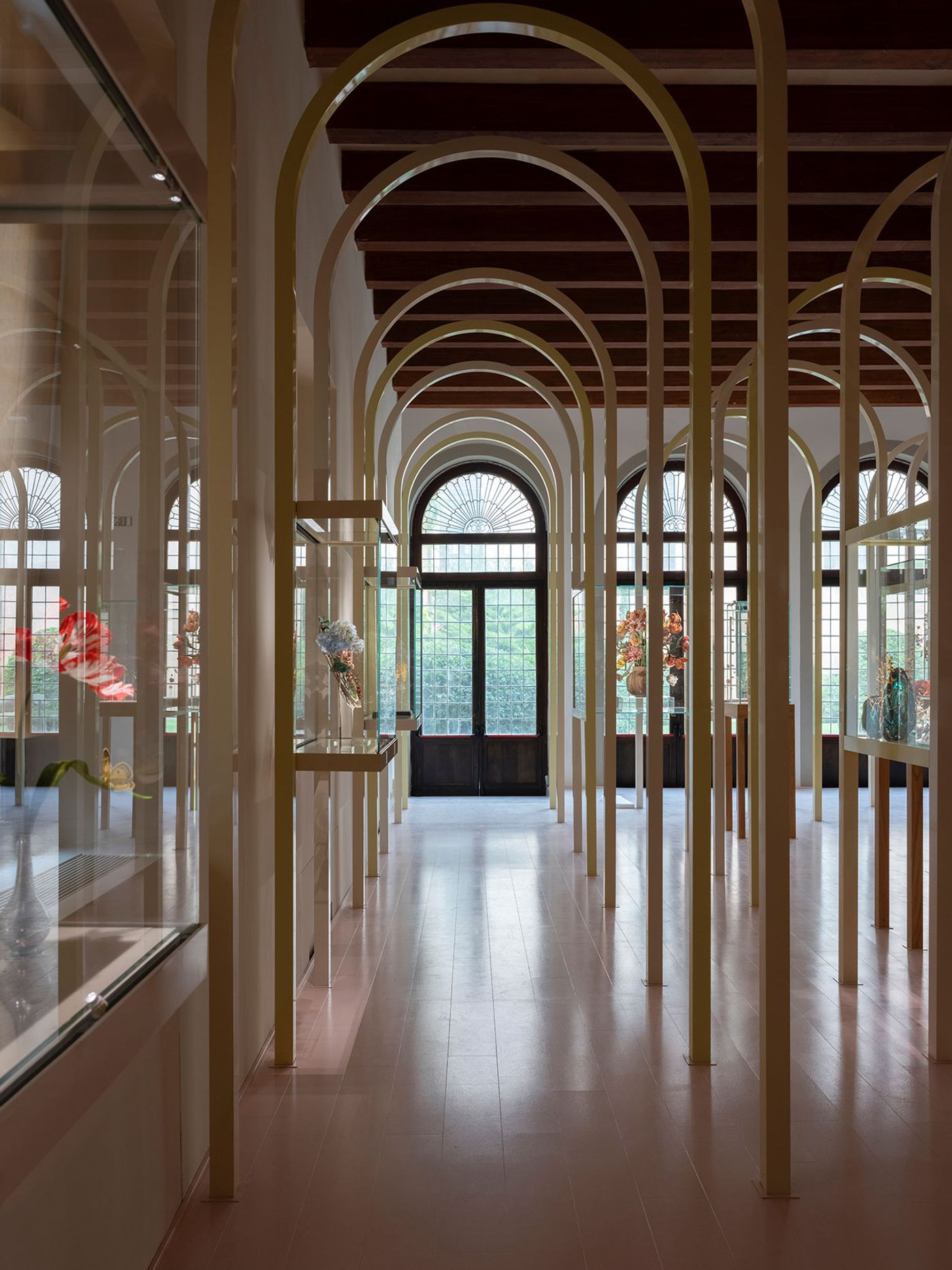
Love (Courtship).
Photography by Giulio Ghirardi. © Michelangelo Foundation.
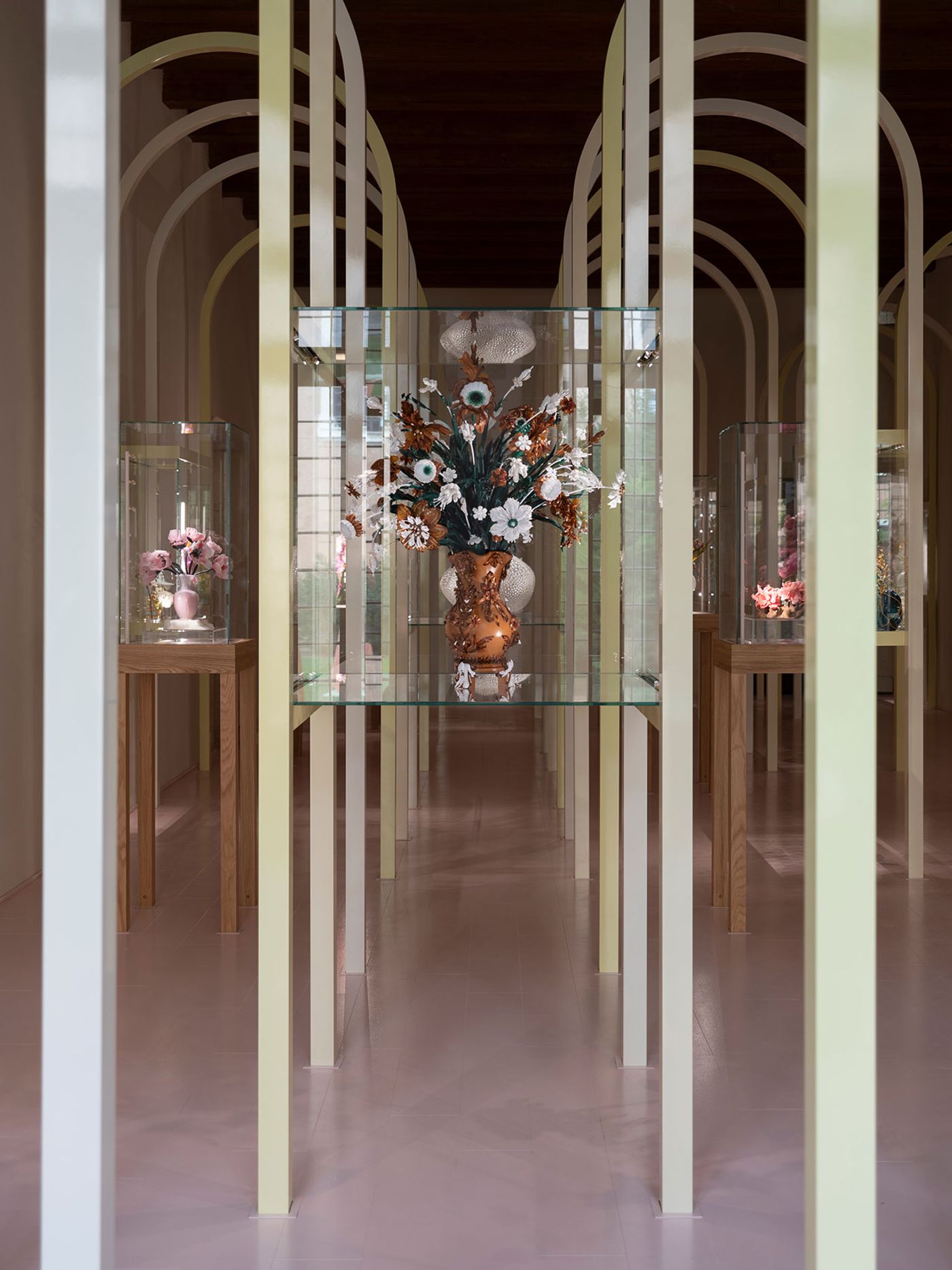
Love (Courtship).
"Grand Bouquet de Fleurs Dans un Vase" (2024) by Atelier Baqué Molinié.
Photography by Giulio Ghirardi. © Michelangelo Foundation.
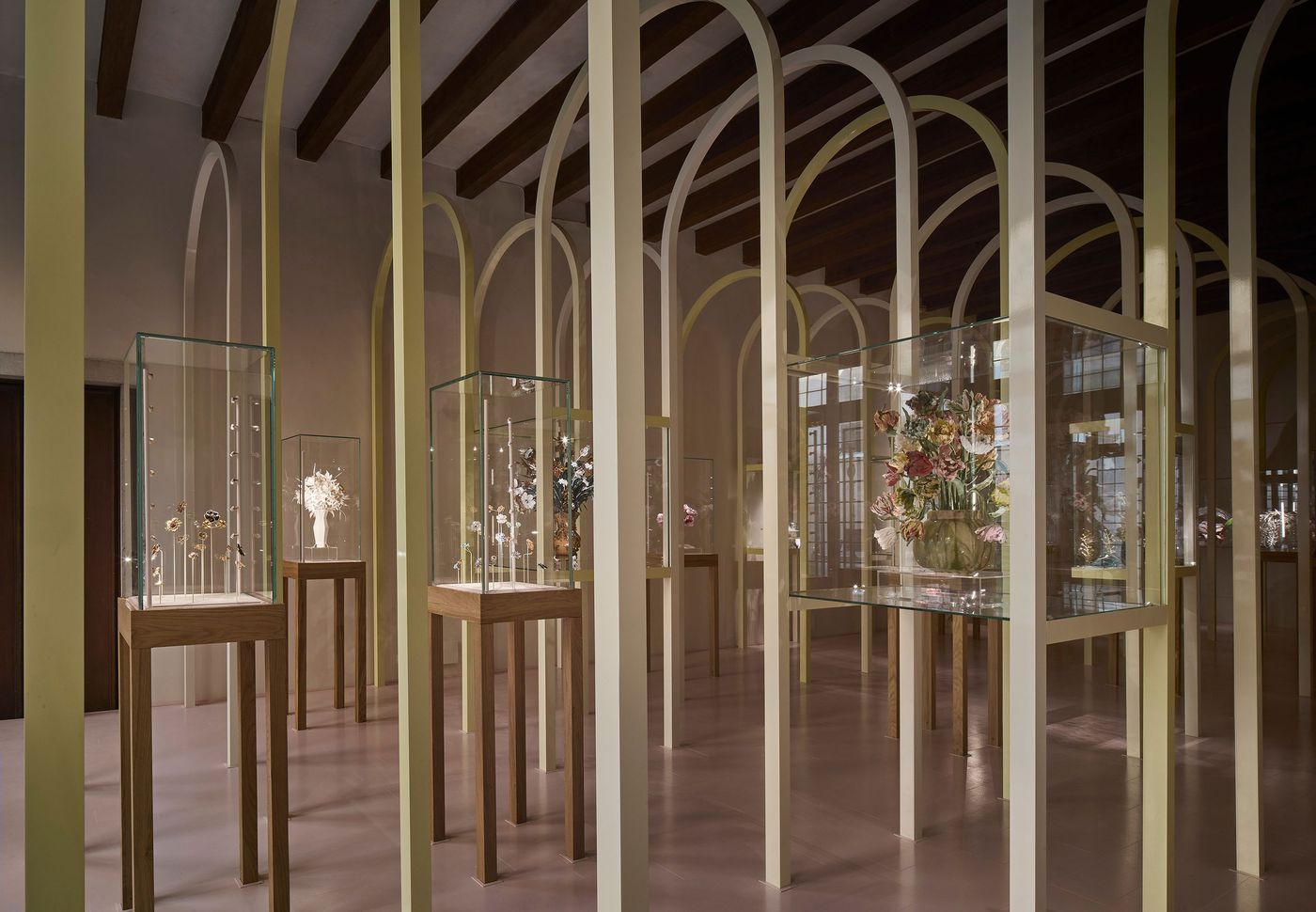
Love (Courtship).
Photography by Alessandra Chemollo. © Michelangelo Foundation.
Much grander in scale, Love (Union) takes over the monastery’s majestic Sala degli Arazzi where a forest of chandeliers creates a phantasmagorical effect. Designed by artistic duo thebackstudio, the dazzling light installation is inspired by the luminescence as a distinctive feature of Panerai’s watchmaking heritage. At one end of the room, a monumental handcrafted woollen carpet over four metres in height by Azerbaijani artist Faig Ahmed beautifully encapsulates the section’s theme thanks to a delicate erotic art scene inspired by a Persian miniature on display as part of the collection of the Musée d'Art et Histoire de Genève.Other participants that pulled at our heartstrings include Italian artist Massimiliano Pelletti's ethereal version of Antonio Canova's statue The Three Grace, handcrafted from Mexican white onyx, mother-of-pearl and malachite, followed by Los Angeles-based, South Korean ceramist Myungjin Kim’s terracotta vessel Owls Court Vessel 1, crafted using the coiling technique, the oldest ceramic-making method predating the throwing wheel, along with a series of cushions by Germany-based, Chilean visual artist Valentina Lobos who spent hundreds of hours hand-embroidering minuscule figures of human bodies using a sui generis technique of her own.
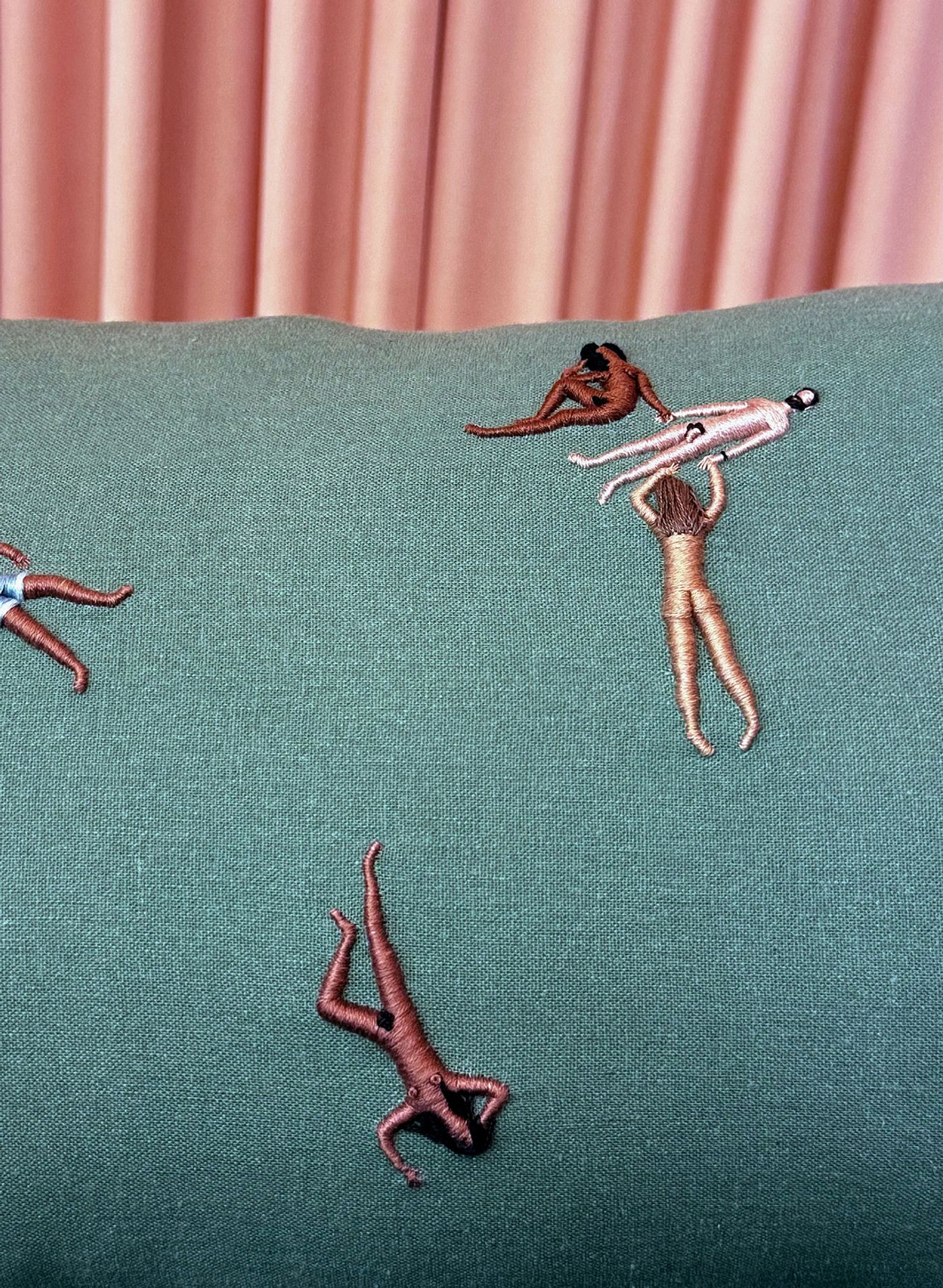
"Dangers of Playing Outside" cushions (2024) by Valentina Lobos.
Much grander in scale, Love (Union) takes over the monastery’s majestic Sala degli Arazzi where a forest of chandeliers creates a phantasmagorical effect. Designed by artistic duo thebackstudio, the dazzling light installation is inspired by the luminescence as a distinctive feature of Panerai’s watchmaking heritage. At one end of the room, a monumental handcrafted woollen carpet over four metres in height by Azerbaijani artist Faig Ahmed beautifully encapsulates the section’s theme thanks to a delicate erotic art scene inspired by a Persian miniature on display as part of the collection of the Musée d'Art et Histoire de Genève.Other participants that pulled at our heartstrings include Italian artist Massimiliano Pelletti's ethereal version of Antonio Canova's statue The Three Grace, handcrafted from Mexican white onyx, mother-of-pearl and malachite, followed by Los Angeles-based, South Korean ceramist Myungjin Kim’s terracotta vessel Owls Court Vessel 1, crafted using the coiling technique, the oldest ceramic-making method predating the throwing wheel, along with a series of cushions by Germany-based, Chilean visual artist Valentina Lobos who spent hundreds of hours hand-embroidering minuscule figures of human bodies using a sui generis technique of her own.
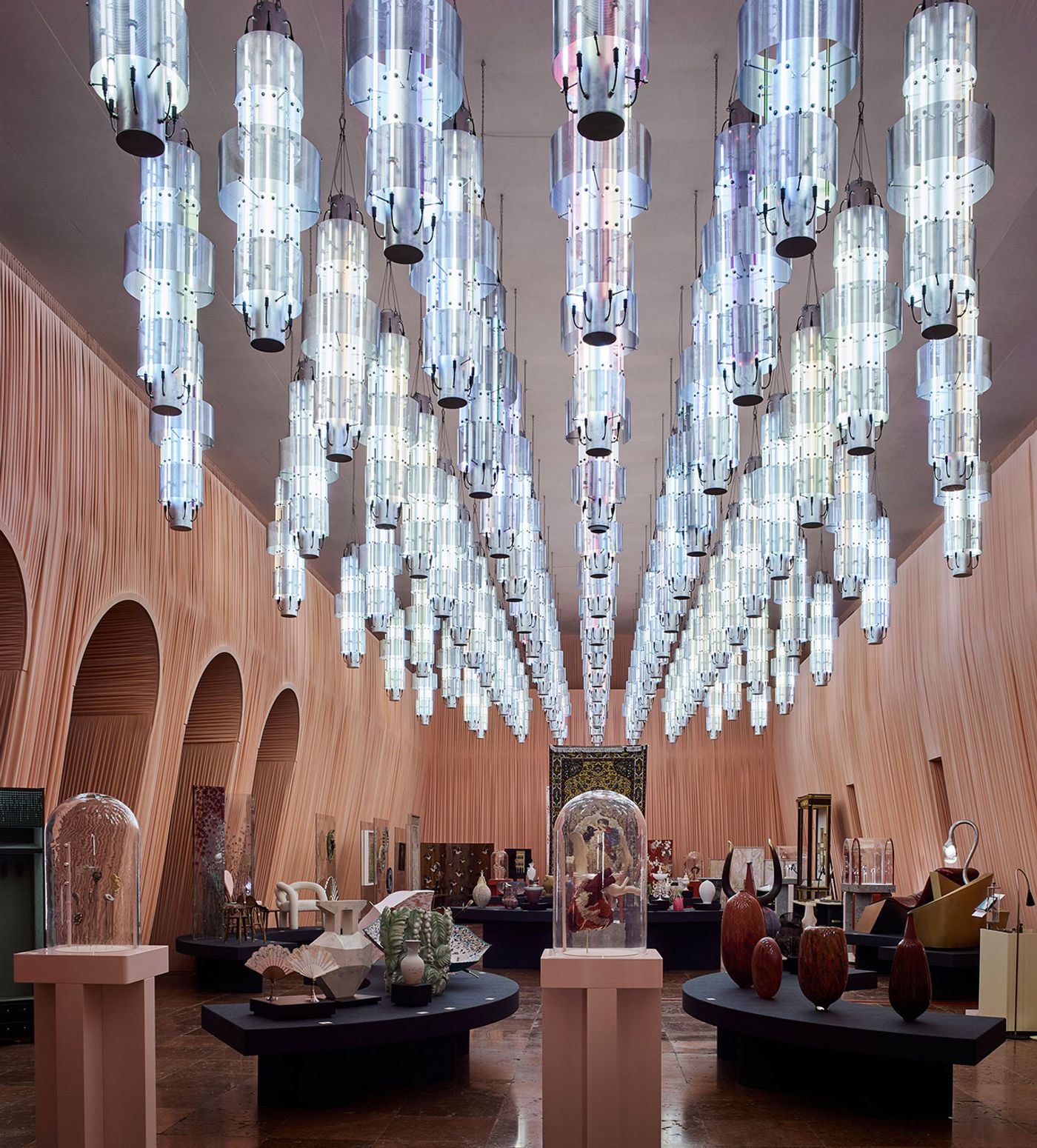
Love (Union).Light installation by thebackstudio and Panerai. Photography by Alessandra Chemollo.© Michelangelo Foundation.

Love (Union).
Photography by Alessandra Chemollo. © Michelangelo Foundation.
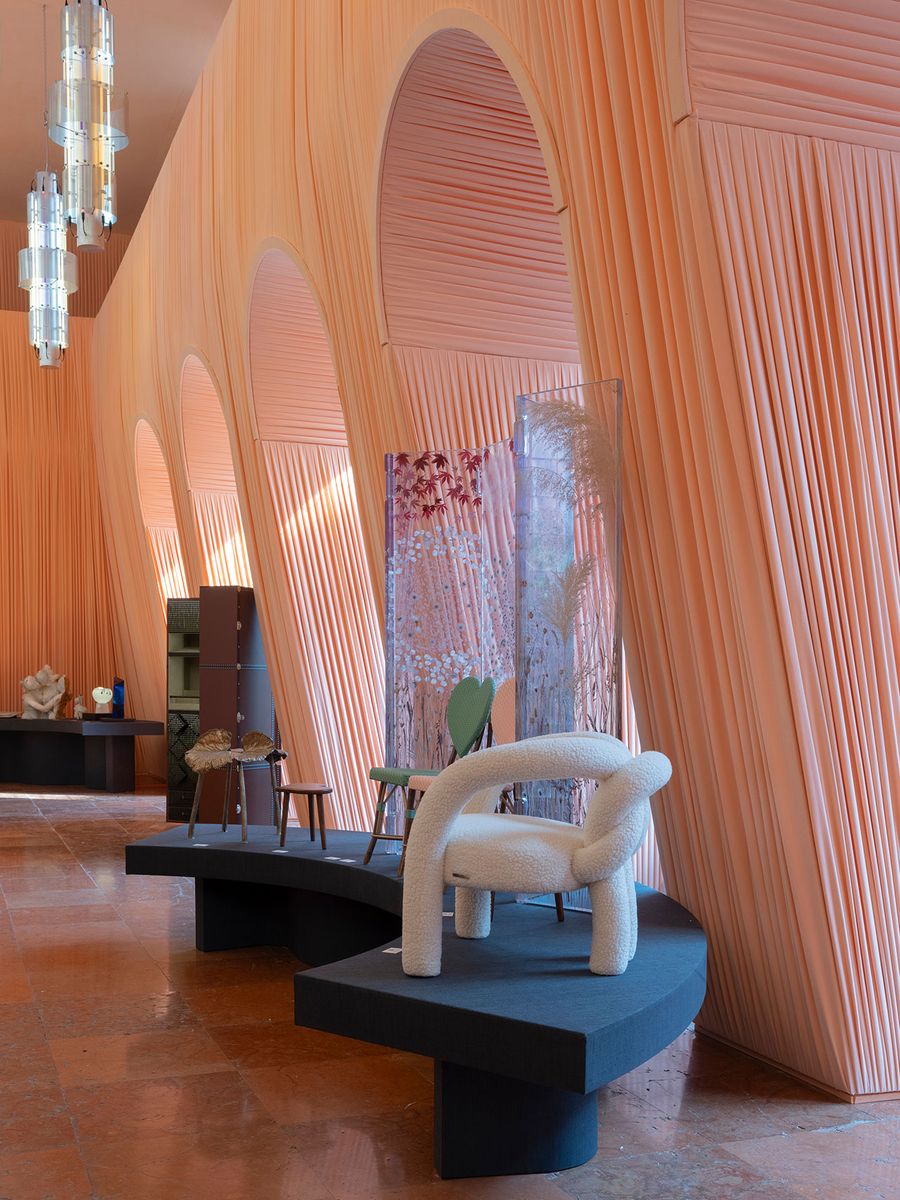
Love (Union).
Photography by Giulio Ghirardi. © Michelangelo Foundation.

Love (Union).Left to right: "Sun and Moon Chairs" (2023) and "Flying F*** Sreen" (2024) by Rooshad Shroff and Theegulla Venkanna; "Corte Nascosta" (2008) by Francois Staub; "Bud of Flower" (2022) by Daria Alyoshkina; "Alp Vessels" (2023-24) by Annick Petersen.
Photography by Alexandre Vazquez. © Michelangelo Foundation.
Next comes Journeys which showcases the handcrafted items we take on holiday as well as objects inspired by travel. Pieces that spoke to us include a 3D world map by UK paper artist Charlotte Bourru, a throne-like armchair by New Delhi-based artist Gunjan Gupta that features traditional cane baskets, and an enlarged interpretation of a Malaysian botanical stamp by Bristol-based Colombian artist Diana Beltran Herrera.Nature follows championing the innovative use of natural materials and stainable craft practices. Highlights include a sculptural clock by Brazilian artisan Henrique Oliveira made of plywood and second-hand furniture, a cedar-wood-framed screen by Marie-Isabelle Callier, a wood marquetry side table in the form of a Caladium Leaf by Brazilian designer Silvia Furmanovich, a corral-like vase that incorporates dried flowers coated in a thin layer of metal by UK artist Marcin Rusak, and a series of vessels sculpted from a single section of ancient lightning-struck oak by Barnaby Ash & Dru Plumb along with a limited edition watch by Swiss luxury watchmaker Jaeger-LeCoultre featuring a superb miniature painting of Monet’s Le Grand Canal.
Unlike the previous light-filled rooms, Dreams immerses visitors into a darkened space centred on Fondazione Giorgio Cini’s former swimming pool where a troupe of faceless mannequins wearing hooded Alaïa dresses appear to be floating on water. The dreamlike setting is further amplified by an eclectic collection of enigmatic masks created by artists and artisans from around the world. Standouts include Spanish designer Cecilio Castrillo’s ‘Medussa’ leather mask, Iceland-based artist James Merry’s bejewelled prosthetic mask, Brussels-based artist Pierre-Louis Graizon’s zoomorphic felt mask adorned with a pyramid-shaped lapis lazuli centrepiece, and Filipino artist Leeroy New’s multicoloured silicone mask that gives the impression that it is melting.
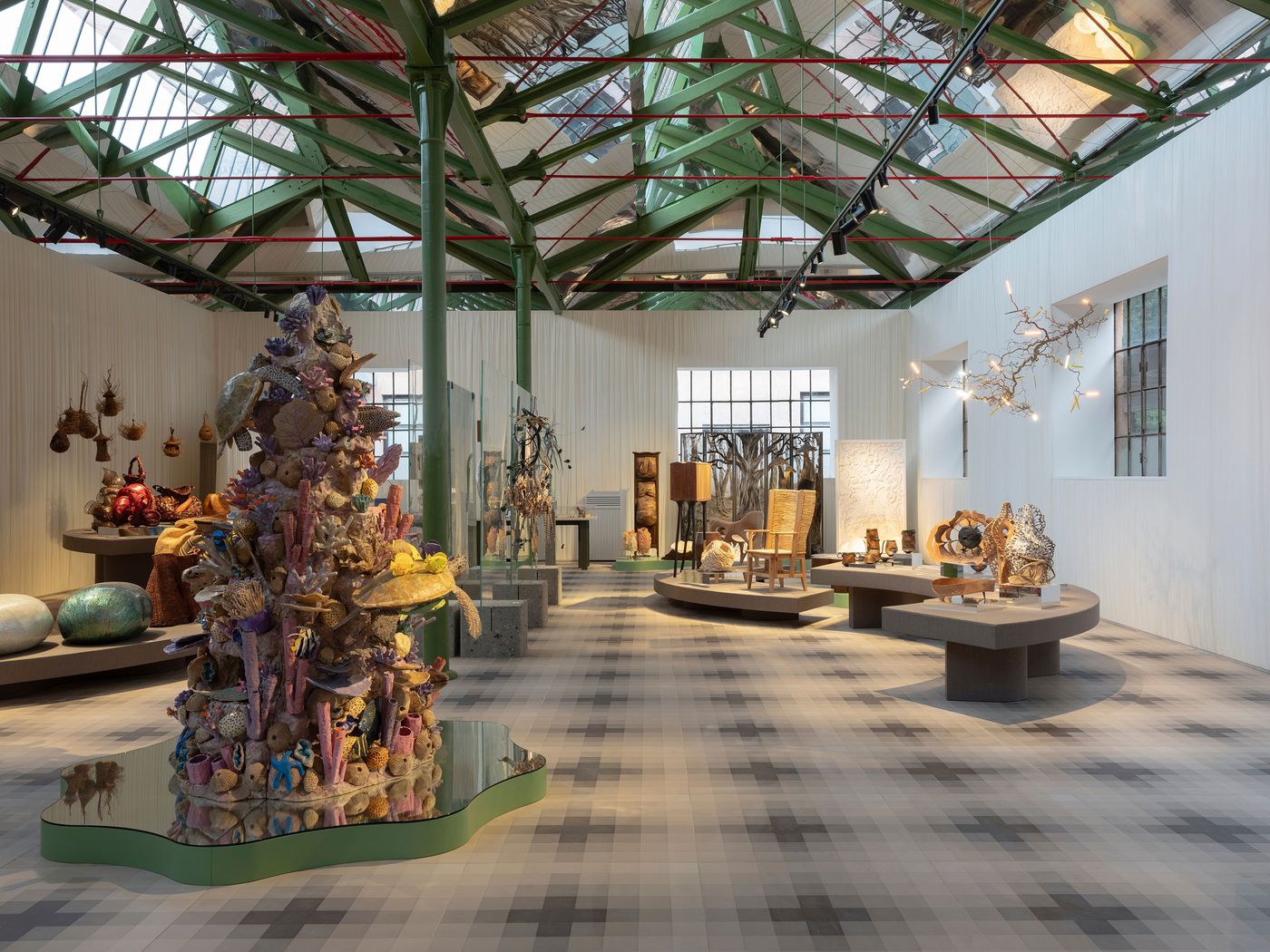
Nature.
Photography by Giulio Ghirardi. © Michelangelo Foundation.

Dreams.
Knitted velvet hooded gowns by Alaïa.
Photography by Alessandra Chemollo. © Michelangelo Foundation.
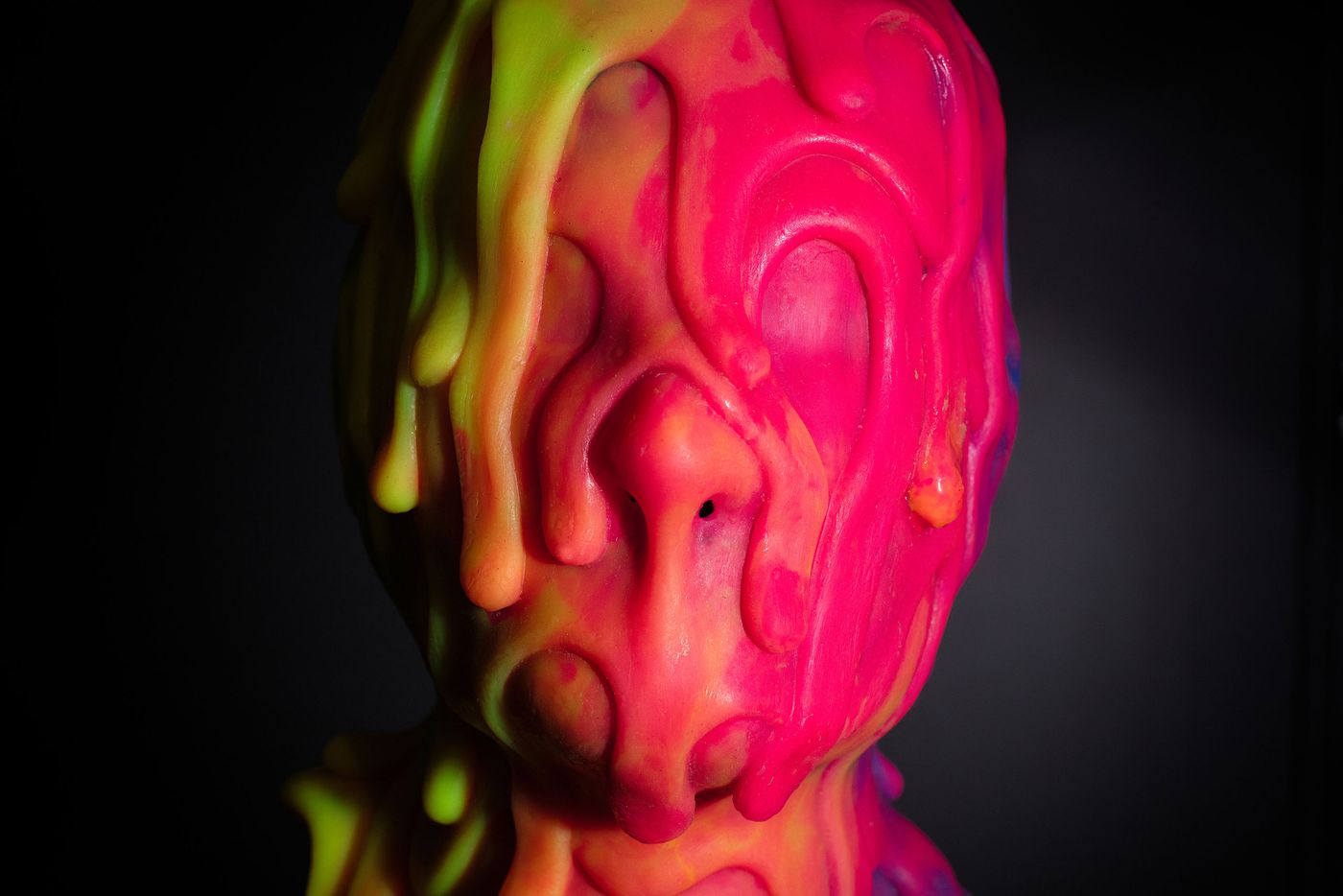
"Melt Mask" (2021) by Leeroy New.
Photography by Alexandre Vazquez. © Michelangelo Foundation.
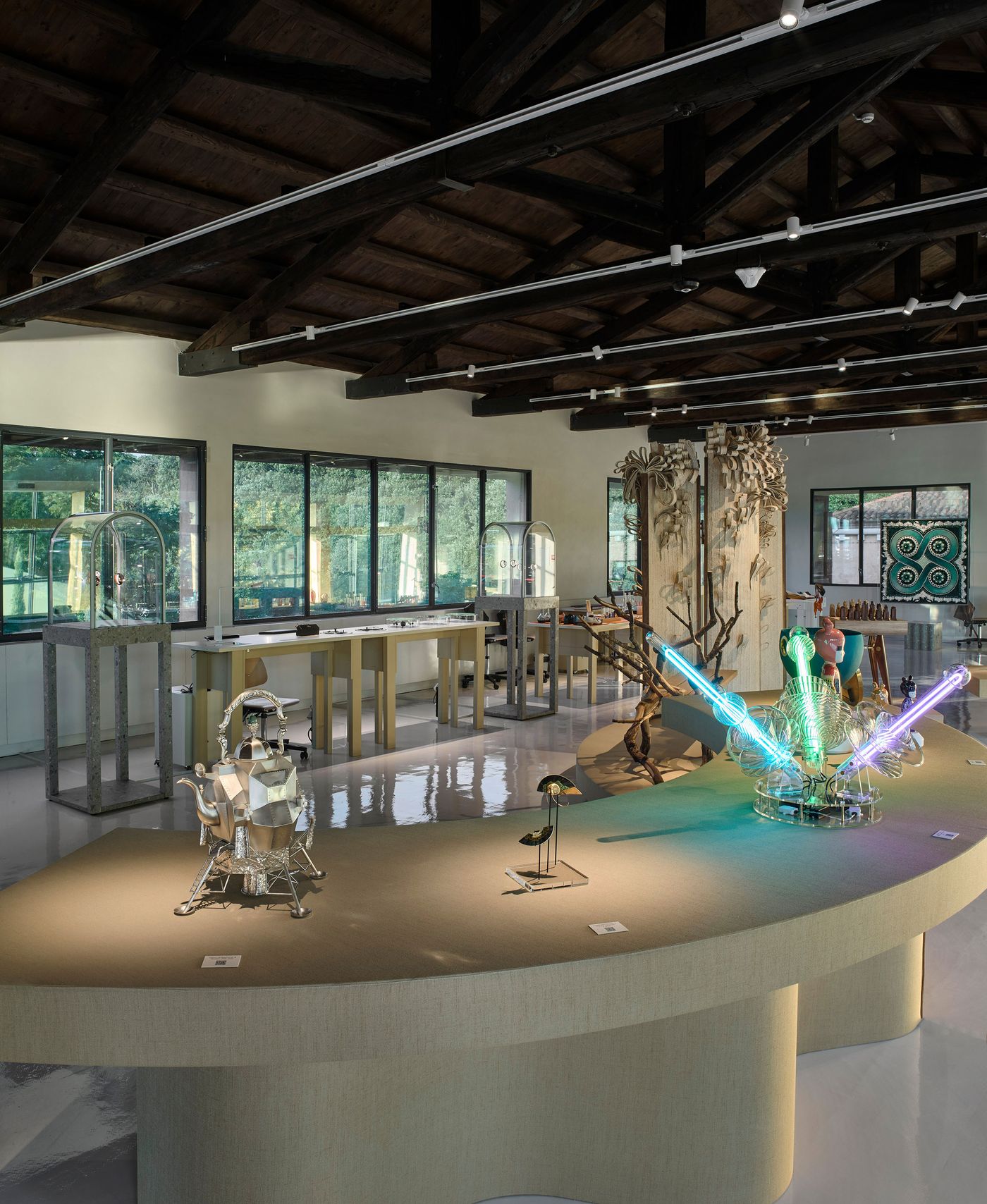
Dialogues.
Photography by Alessandra Chemollo. © Michelangelo Foundation.
Creative collaborations have always been an important part of the design world, represented in the next thematic section, Dialogues, which showcase a diverse collection of objects collaboratively created by artists and artisans. Standouts include a glass-topped ping-pong table by Milan-based design studio Impatia and Turin-based Adriano Design, a retro-futuristic lamp inspired by swimming caps and 1960s sci-fi fantasy, the work of Italian glassmaker Pietro Viero and UK designer Bethan Laura, and two handcrafted porcelain sculptures by French multidisciplinary artis Guillaume Grando, a.k.a. Supakitch, for Spanish ceramics brand Lladró based on Spanish designer Jaime Hayon’s The Guest character. At the same space, live demonstrations by artisans from renowned Maisons provide rare glimpses into the meticulous craftsmanship involved in watchmaking, jewellery making, shoemaking and more.
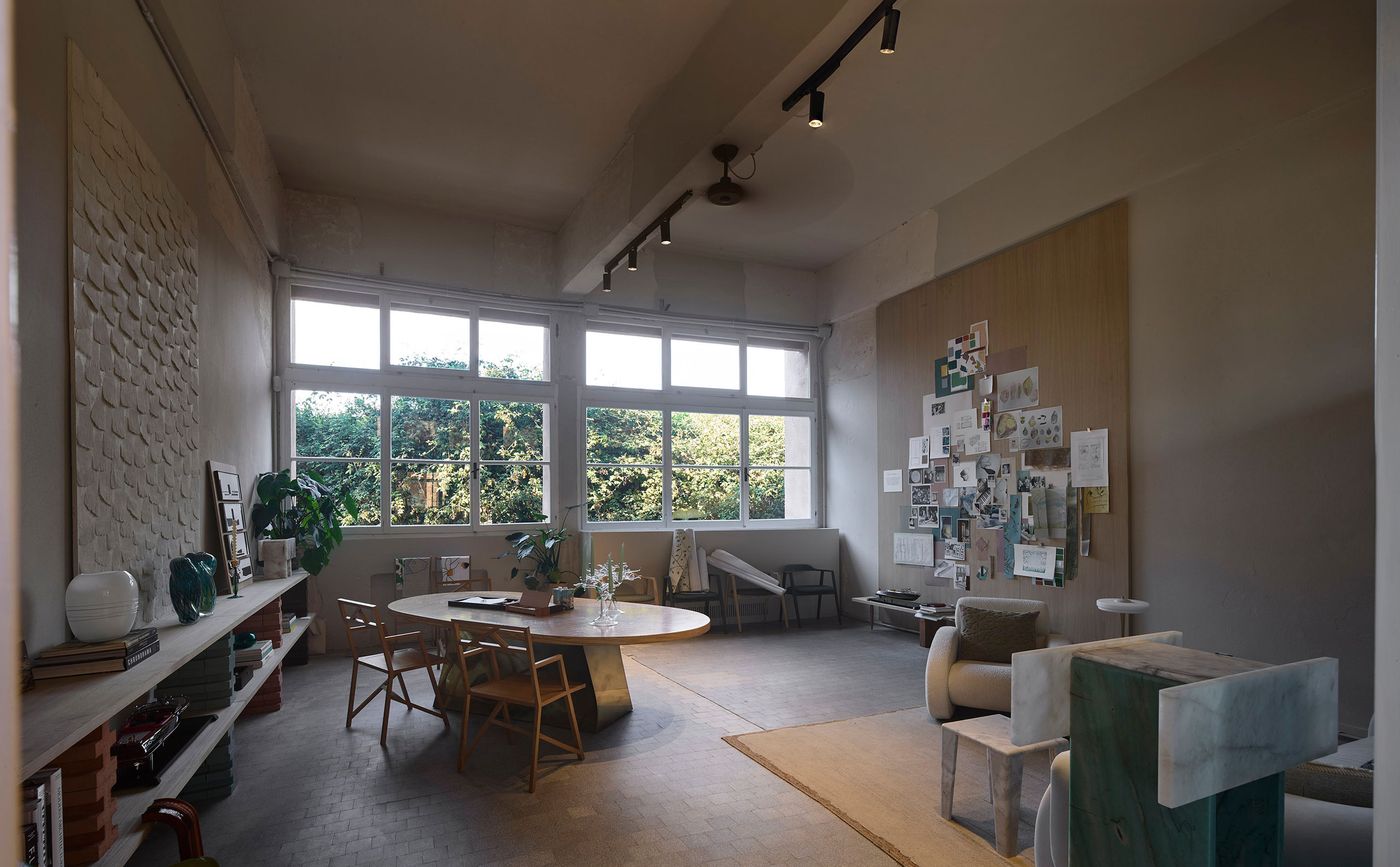
Via Arno Salon.Photography by Alessandra Chemollo.© Michelangelo Foundation.
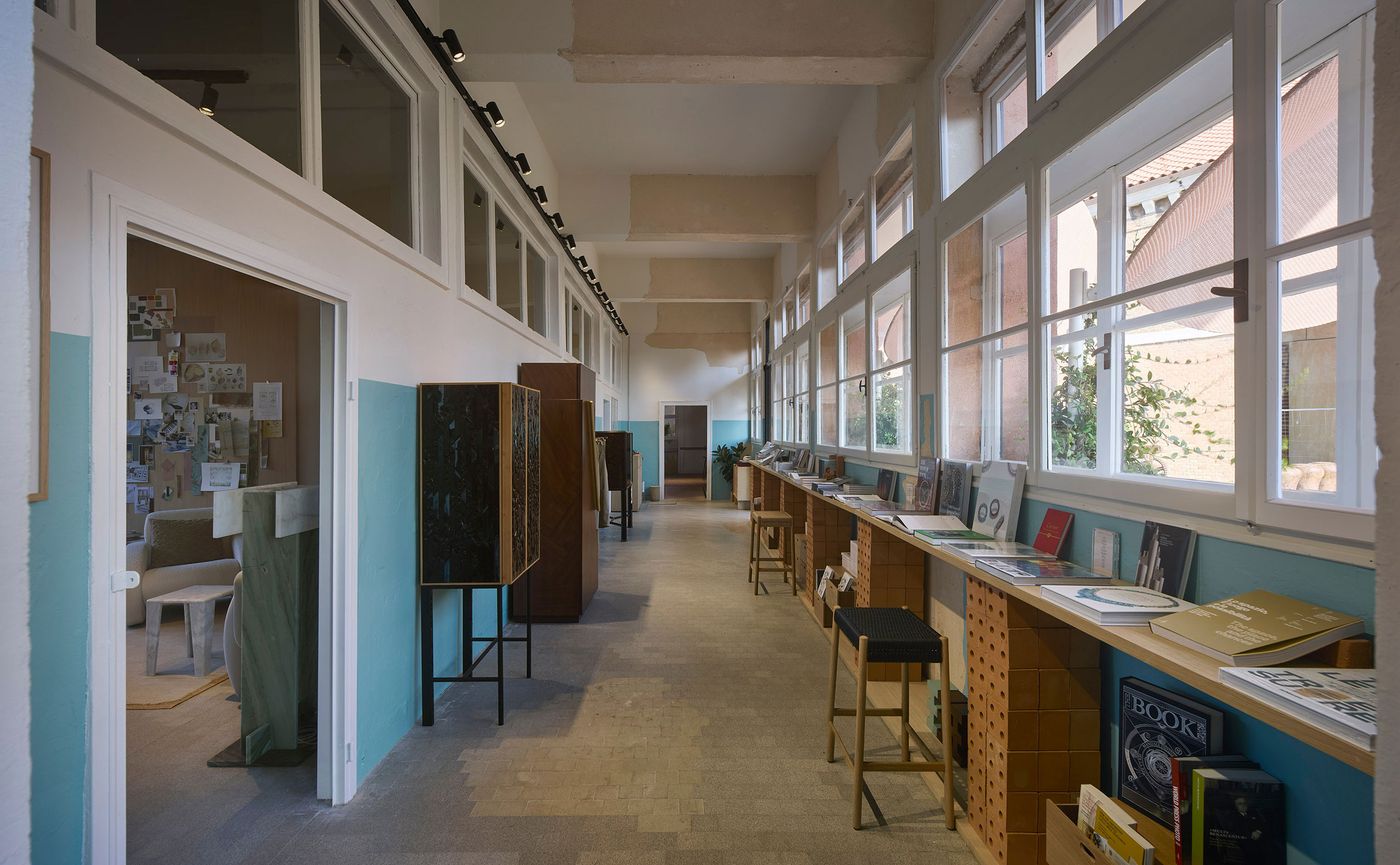
Via Arno Bookshop.Photography by Alessandra Chemollo.© Michelangelo Foundation.
Concluding the exhibition, Afterlife encourages visitors to ponder upon metaphysical questions with a haunting collection of unsettling yet enchanting objects. The curation includes works such as Japanese ceramist Katsuyo Aoki's Predictive Dream series of intricately sculpted porcelain skulls that tiptoe a fine line between the sacred and the profane, and London-based artisan Anna Rubincam's stone bust of a veiled woman caught in a gust of wind. While the theme of confronting death might seem an unusual choice for an exhibition celebrating fine craftsmanship, it aligns perfectly with the essence of what makes these objects so enduring. Beyond their uniqueness and exquisite quality, these creations are cherished heirlooms, carrying a legacy that can be passed down to future generations. In fact, the idea of continuity and the transmission of meaning across time runs throughout the exhibition, underscoring the event’s key tenet: that contemporary craftsmanship can create a bridge between past traditions and future creativity.
If the idea of ten themed exhibitions showcasing over 800 objects sounds overwhelming, and it kind of is—if you plan to see everything in one go, a couple of espresso breaks are definitely recommended. And that’s just what’s on offer at San Giorgio Maggiore island! Visitors can also explore around 70 artisanal workshops across Venice as part of Homo Faber in Città, a program developed by Fondazione Cologni dei Mestieri d’Arte with the support of Cartier. Additionally, this year’s edition provides a sneak peek of Via Arno, a soon-to-be-launched digital platform by the Richemont Group that aims to sell “the world’s best craftsmanship”, represented by a curated showroom at Fondazione Giorgio Cini, accessible by invitation only.

Via Arno Bookshop.
Photography by Alessandra Chemollo. © Michelangelo Foundation.
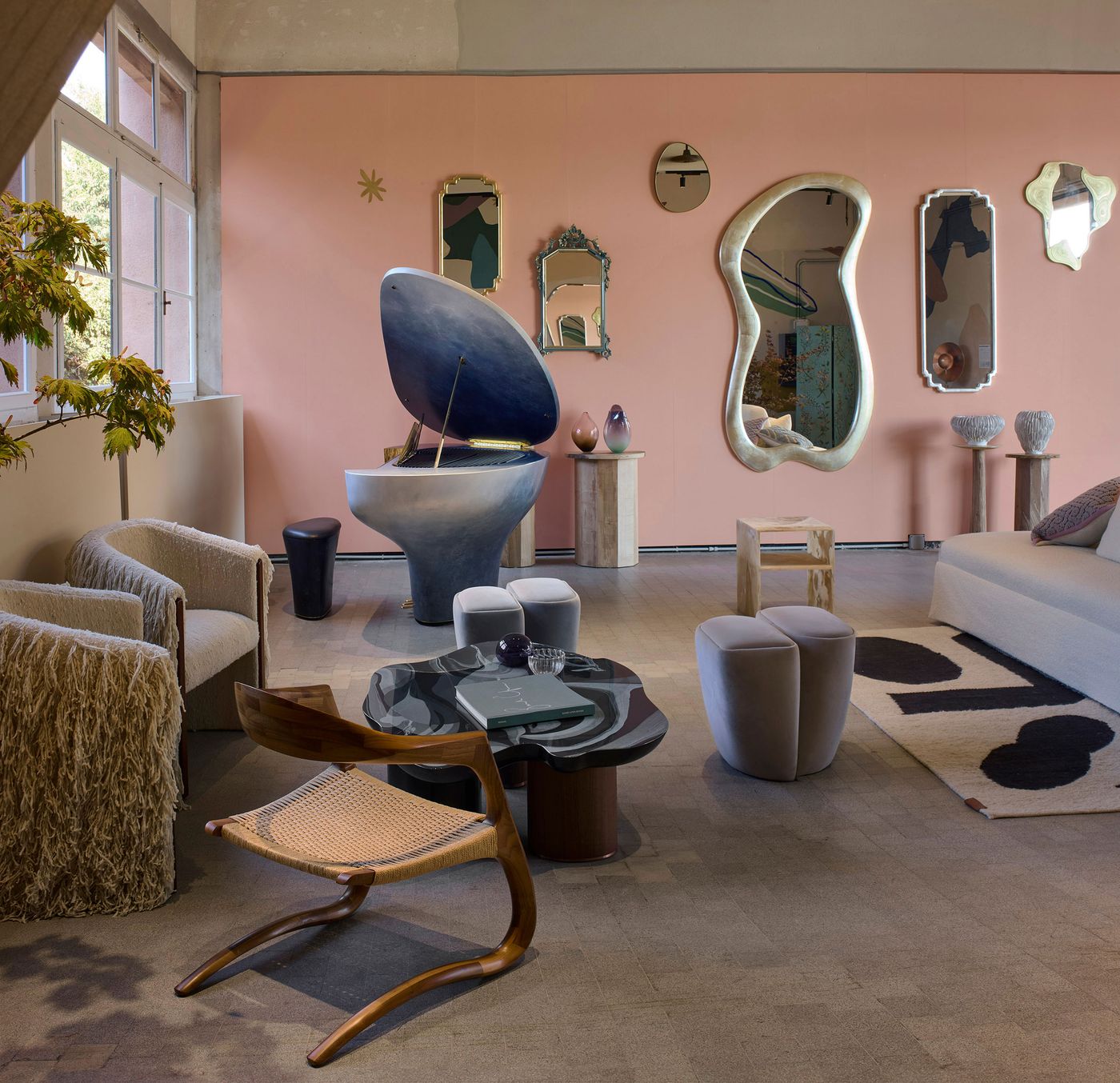
Via Arno Salon.
Photography by Alessandra Chemollo. © Michelangelo Foundation.
